#while also representing being a game developer in general
Explore tagged Tumblr posts
Text
hi sorry to randomly talk about deltarune theories on main but the recent newletter's got me thinking about it: i don't think it's actually that much of a stretch or contradiction that both the player and noelle are "the angel" in the lore of deltarune. i think it's very possible that being the angel is less of an individual person thing and more of A Force. noelle's ability to break video games is obviously one of the reasons the weird route can happen, but she isn't able to do it without the player's intent. in my eyes, the angel is not a singular person, but rather the combination of the player and noelle to form a singular force of will. or perhaps not and i need to watch less youtube
#i listen to. a Lot of deltarune theory videos while i work on commissions.#earlier i was watching one about the metatextual significance of gaster representing both video game creepypastas and easter eggs#while also representing being a game developer in general#god. its crazy how good deltarune is AND ITS NOT EVEN FINISHED#doc talks#deltarune#utdr
75 notes
·
View notes
Text
A (possibly) helpful guide to the Nikki-verse for Infinity Nikki Players
❄️Updated December 28th
Although it’s not at all necessary to know the lore of the previous games (Love Nikki, Shining Nikki), here is some info that you might benefit from if you’re joining the fandom with Infinity Nikki!
❄️General Info:
Love Nikki, Shining Nikki, and Infinity Nikki are all stand-alone games with self-contained stories, but they have some commonalities that I will get into later.
Love Nikki (LN) has a 2D art style, and is where many of us "veteran" players began our journey. Shining Nikki (SN) has both 2D and 3D art. Both of these games are stunning, so check them out!
Before Love Nikki, there were two other dress-up games in this series that did not involve being transported into a magical world. They were called NikkiUp2U (released 2012) and Hello Nikki (released around 2016). These games are more obscure, with the latter currently only being available in China, so not much is known about them to international fans.
The developers of the game are Chinese, so expect to get a lot of goodies around Lunar New Year and other major Chinese holidays!
According to Hello Nikki, our main character is around 19 years old. In Shining Nikki, she talks about how she used to go to college before getting transported to Miraland. Her birthday is December 6, which is why Infinity Nikki came out last week and why we got a free outfit (we’ll get a new one every year!)
Nikki's Chinese name is Nuan Nuan, how cute!
Momo claims he’s not a cat, but a member of the “Momo Clan” (LN). He was a little annoying in Love Nikki, but he’s more endearing in later games.
Nikki and Momo are the only recurring characters in the franchise.
The biggest advice I can give as a veteran is: Don't bother with trying to make a visually cohesive outfit for styling battles unless you have a lot of clothing. We've all tried it. It won't work. For now, just layer on everything that has high stats. You're always free to wear your fashionable outfits during regular gameplay, and "glow up" your favorite clothes when you have enough resources, so that you can make better outfits for later battles.
I've seen a lot of people in other places asking about whether the Nikki games will have more androgynous or masculine clothing, and they probably will! It took a while for these clothes to appear in LN and SN, but there are definitely several options out there, from ouji fashion to streetwear to military-style outfits. Read about the seven nations below to find out more.
A lot of people also seem curious about representation for people of color. Unfortunately, the options can be quite limited, as it took a while for textured hair options to appear for players in Love Nikki, and I'm not quite sure about the situation in Shining Nikki. Different cultures are represented in Miraland (as explained below) but they still have their limitations. With Infinity Nikki being more oriented towards an international fanbase than previous games, though, perhaps the developers will be encouraged to branch out more.
❄️Worldbuilding
The world that Nikki has been transported into is called Miraland.
Miraland is composed of seven nations, each with their own distinct fashion style. That means that if you do not like the style of clothes we’ve been seeing so far in Infinity Nikki, do not worry! They’ll have everything eventually.
For some reason, they changed the names of the countries in Infinity Nikki, and I’m not sure why (I’m going to keep mixing them up…). Below, I’ve listed their LN/SN names first, and their Infinity Nikki names second.
The seven nations are:
🎀Lilith/Ninir/Heartcraft Kingdom: In the older games, it was known mostly for fairytale-inspired clothing and lolita fashion, with the occasional “pastoral” suit. It looks like Heartcraft Kingdom in Infinity Nikki has been leaning more into the pastoral aesthetic, but Nonoy’s outfit seems to be in the lolita style. Also, the suits we have been crafting so far for catching bugs and petting the animals is at least lolita-inspired. (People who wear lolita fashion, please correct me if I’m wrong, but I think the Chinese version of this fashion is a lot more loose with the rules than the Japanese version I am more familiar with). This kingdom is always the first to be introduced in these games. Expect drama to follow whenever we get introduced to the royal family of this kingdom…it always happens. Nikki's first friend is always from this kingdom--we started with Bobo in Love Nikki, then Joy in Shining Nikki, and now Nonoy in Infinity Nikki.
🐉Cloud Empire/Lanling Empire: Known for traditional and modern Asian fashion. A vast majority of the fashions are going to be inspired by Chinese fashion, so if you’re a fan of period dramas or xianxia, you’re in luck! Aside from hanfu and qipao, they also usually have some representation of other East Asian cultures, featuring several kimono and the occasional hanbok. (Due to some controversies in Shining Nikki relating to conflicts between China and Korea, however, I’m not sure if the developers will continue to add hanbok in future games). Love Nikki also included some outfits for Chinese ethnic minorities like the Miao, and Vietnamese ao dai if I remember correctly. All games also have at least one Peking Opera costume—it’s like an industry staple. Overall, Cloud Empire is usually the second kingdom to be introduced in the game, so I’m sure we’ll see it pretty soon. Maybe we’ll go along with Tan Youyou, depending on how the story will go.
👠Apple Federation/Starhail Federation: Known for streetwear, high fashion, and casual clothing (like what you’d wear on an average day). I think Dada and Bebe’s outfits would be classified as Apple, even though they live in Heartcraft. Unlike the rural towns we have seen so far, Apple tends to be a very urban, city-based environment, filled with spies and shady businessmen. Nikki's girlfriend, Kimi (from Love Nikki), is also from here.
👑Pigeon Kingdom/Twinmoon Kingdom: Known for European fashions, including fairy costumes, witch/sorcerer outfits, Rococo dresses (with long skirts, compared to the lolita style in Lilith/Ninir/Heartcraft), and anything else you’d expect to see in a Western fantasy or period drama. Funnily enough, there is always at least one scene in the Pigeon Kingdom that has to do with a cathedral, so expect some fashions with gothic and Catholic-inspired imagery as well. Some of the inhabitants who live there are elves and fairies, like Timis. Although most of the ability outfits we have so far look like they're from Lilith/Ninir/Heartcraft, the "purification" outfit strikes me as something more typical of Pigeon.
⚔️North Kingdom/Empire of Light: A cold country best known for winter clothing—heavy scarves, overcoats, and hats—as well as military attire. There is also at least one "ice queen" style suit in every game. If I recall correctly, this kingdom has been having civil wars since Love Nikki, so expect a lot of action in this area. I suspect that Bettina is from here, but I'm not sure yet.
🐪Wasteland/Terra Alliance: The original name of this country sparked a lot of controversy, so I'm glad that they have changed it. This kingdom usually has desert-themed clothing, ancient Greek/Egyptian clothing, clothing inspired by nature, bohemian clothing, South, and Southeast Asian clothing (the cultural representation isn’t always the best, unfortunately…but I am optimistic that Shining Nikki and Infinity Nikki are more culturally sensitive than Love Nikki).
🤖Ruin Island/Whaleport: A mysterious island that features “futuristic” or sci-fi inspired clothing. In previous games, we have seen medical doctors with dubious legitimacy, scientists who experiment on themselves (?) and androids, so I’m curious to see who we’ll meet this time. Many players from the previous games who liked this style have felt that the developers often neglect this kingdom, unfortunately.
❄️Story and gameplay advice
Without spoiling the older games, I can say that, generally...
Most of the story is based on conflicts between different characters and sometimes different kingdoms. These problems, as mentioned before, are solved through styling battles.
Infinity Nikki seems to be going for a cozier vibe. However, both of its predecessors have sometimes gone into dark territories, featuring themes of war, violence, and betrayal. (I may or may not have cried over the death of a certain someone in Love Nikki...)
Therefore, dramatic things could very well happen in Infinity Nikki. I'm not saying that it can't be your comfort game if that is what you are hoping for, as the other games can still also be light, funny, and cozy. I just want to warn more sensitive players who might not be expecting it from a dress-up game.
When I first wrote this guide, I initially thought that the miracle outfits were like the "lifetime suits" of previous games, where crafting them was optional and not necessary to progress through the story. However, this seems not to be the case. Nevertheless, take your time while crafting them--there's no need to rush.
I'm not sure how f2p-friendly Infinity Nikki will be, but I haven't spent anything on either of the other games and I've been able to buy many of the suits I wanted. Just make sure that you budget accordingly and remember that if you want one suit but can't afford it at the time, another suit with a similar aesthetic might come out in the future. Also banners can re-run!
Keep an eye out for redeem codes! These are often posted by the game's social media, and you can get a lot of free stuff.
The fan-favorite kingdoms are usually Lilith/Ninir (Heartcraft) and Cloud (Lanling), followed by Pigeon (Twinmoon) and Apple (Starhail). The other three tend to get neglected, so if you like the sound of those the most, I'm sorry... :(
The last two sections include speculation, trivia, and an explanation of some inside jokes from the other games. Feel free to skip them if needed!
❄️Continuity and Fandom References to Other Nikki Games
Like I said earlier, the Nikki games can all work as standalone games, and the only returning characters are Nikki and Momo.
However, I've added this section to discuss possible theories and connections, as well as catch others up to speed on some of the inside jokes and characters that we Nikki veterans like to talk about.
If you keep hearing names like "Bobo," "Lunar," "Kimi," and "Nidhogg," these are characters from Love Nikki.
Bobo and Lunar are some of the first characters we met in LN. Kimi is the closest character we have to a canon love interest for Nikki. All of them are fan-favorites, so we're hoping to see any references to them in Infinity Nikki as well.
I can't say much about the very controversial and very popular Nidhogg without spoiling LN, but at least you now know where the name is from.
In Love Nikki, there is a "blood curse" that prevents people from using violence. Therefore, people often resolve conflicts by entering styling battles and destroying each other with the power of a good outfit.
Never ask a Love Nikki player what happened in Chapter 15.
Shining Nikki takes place roughly 700 years before Love Nikki, where there is no blood curse (which means certain people have managed to commit certain crimes...). Several SN characters are the ancestors of, or otherwise related to, LN characters.
Nikki veterans often like to make references to Ashley, Lilith (the person), Joy, and Qin Yi. These are all Shining Nikki characters.
So far, we haven't seen such a connection between old games and Infinity Nikki, so a lot of people suspect that this might be an alternate universe. When more about this version of Miraland is known, I might make another post.
❄️My predictions for future updates
Every time we enter a new country in Miraland, we will have new ability outfits to craft to fit the style of the new setting. This is because most of the outfits we have so far look like Lilith/Ninir suits in previous games, with very few influences from other nations.
The next country to be introduced will most likely be Lanling. I originally thought that they'd let us visit Lanling in time for Lunar New Year, but with the scope of the story, I think it may take some more time before that.
The next big update will be around Lunar New Year, where they'll probably hold some five-star banners, give free diamonds as a login event, and make a new short story, if they celebrate the same way as in Shining Nikki. They're probably also going to give us another free suit. (I hope it's Legend of the White Snake themed, since next year is Year of the Snake!)
Then, we'll probably see the equivalent of the Apple Federation, followed by Pigeon Kingdom.
We will get a new version of this stunning dress. It's called the Star Sea and has shown up in every game so far. I'm actually surprised we haven't heard about it in Infinity Nikki yet.
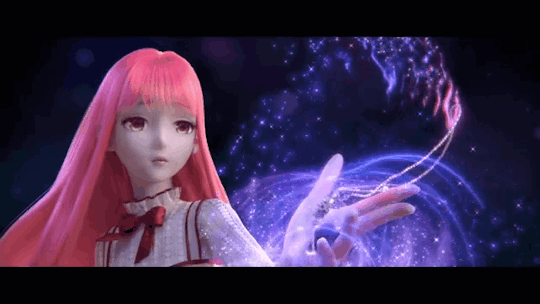
Please let me know if this guide has been useful, and if there's other parts of the games you'd like me to cover!
2K notes
·
View notes
Text
Archie Sonadow is the most unfairly underrated version of the ship
A while back, I did a poll to decide which was the most underrated version of Sonadow across different media, and since the public has had their say, I'm now going to offer my own take and explain why from Archieverse Pre-SGW version is so good and deserves much more recognition.
The beginning of their relationship is practically the same that in the video games: Shadow is accidentally awakened by Eggman and decides to carry out his creator's revenge against the world for killing Maria. Sonic is mistaken for the black hedgehog and is chased, which leads them both to have a series of confrontations until they reach the ARK Space Colony. There is a curious change here; since in the comic universe, Amy was involved in another separate story while the conflict was taking place, she was absent during these events but, according to Shadow's own words some time later, Sonic made him see the light, interpreting that he made him change her mind and since Rouge fulfilled exactly her same participation by broadcasting Gerald's video, it could be interpreted that in this universe it was Sonic who made Shadow remember Maria and finally pushed him towards the heroic side. Something like what happened years later in the third movie. (STH 98#, STH 124# & SU 2#)
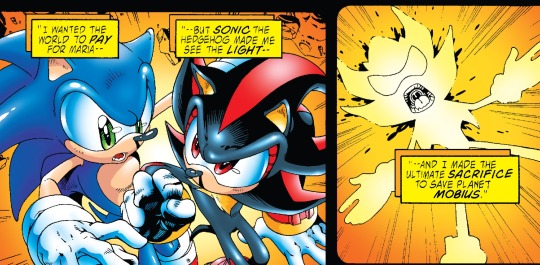
After this, Shadow sacrificed himself and also lost his memory when he hit Mobius. From here the events differ from the games, in this version Shadow falls and is found by Sonic and the Freedom Fighters, showing himself hostile at first due to his confusion, although soon after he ended up allying with them to face a greater threat, the Alien race known as The Xorda who also planned to destroy the world in an act of revenge, which ends up being stopped with Sonic's sacrifice and disappearance that leaves everyone shocked, including the black hedgehog, because it was thought that the blue hedgehog had died saving the world until his eventual return issues later (STH 124 # & 125 #)

It's curious how, despite not remembering it clearly, Shadow during this stage showed a certain appreciation for Sonic, admitting that he is a being different from any other he has ever met. Of course, that didn't prevent them from continuing to have confrontations in their following encounters but over time, Shadow began to gain confidence in Sonic and was willing to collaborate when the situation required it. (STH 146-149# and STH 157-159#)

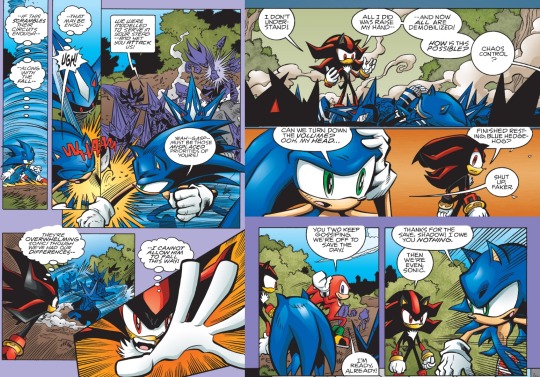

Meanwhile Sonic, despite their previous battles, never believed Shadow to be evil, even in the brief time where he was working with Eggman for the second time, and was sure that he would eventually do the right thing. And when that happened, Sonic supported him and helped him without hesitation to discover the truth behind his origins. (STH 160# &STH 170-171#)
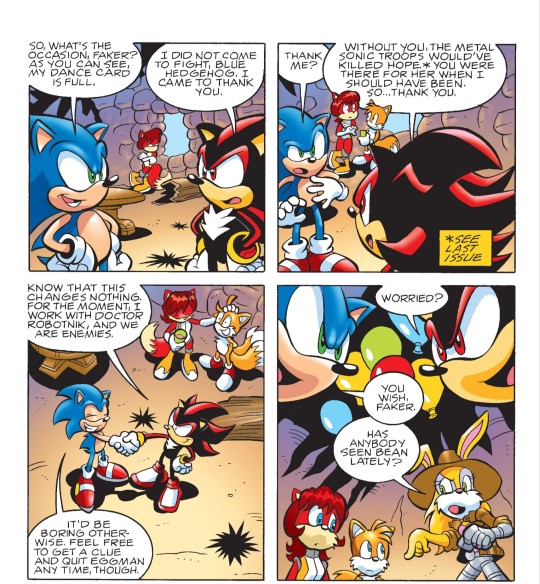

After this point, Shadow became an increasingly notable ally, occasionally appearing and helping the heroes when needed, over time developing a respect and even appreciation for those who helped him become who he is today, obviously including Sonic between them.

Throughout this continuity, the relationship between the two hedgehogs had a long but natural and well-carried development, going from rivals and occasional allies to gradually forming a bond of companionship where, even if their ideals remain disparate, they have generated a mutual respect for each other and a great synergy in battle. Which is spectacularly represented in the last issue where the two interacted within this continuity, in the Sonic Universe 2#.
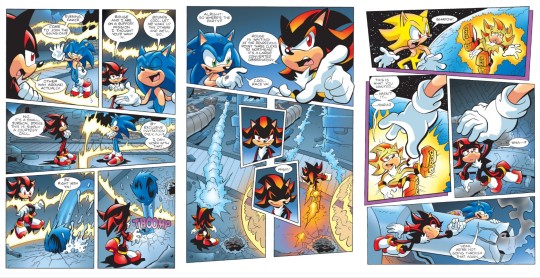
And is for all of this that I think Archie Sonadow deserves more love, because I dare say that it is one of the best and most complete versions of their relationship.

#sonic the hedgehog#sonic#sonic comics#sonadow#archie sonic#shadonic#sonic archie#sonic x shadow#shadow the hedgehog#shadow x sonic#shadow#sonic archie comics#sonshadow#sonshad#shasoni#shadsonic#sth
192 notes
·
View notes
Text
Guess who watched X-Men origins again
OK SO I got THOUGHTS of this movie but specially Wade's fight style because it's really similar to our current Deadpool's fighting style... so yeah I wanna yap about that hi
WELL FIRST OF wanna talk a lil about Victor, Logan and Wade's different styles... from a mortal's view point I am no expert on this just insane about these movies and I need to write my thoughts or i'll explode
Starting with Victor!! the ultimate kittycat girlypop
I love his kitty self I'm sorry ANYWAY EXAMPLES

youtube
OKAY SO VICTOR. Victor's style is obviously very animalistic but also stylized, he makes the fight a show for himself! He likes to hunt and he tries to always give chase or play around a bit before the kill, just like a cat playing with his food!
AND IF you pay attention to the start of the movie, this game he's got with his target isn't initially how he fought, he kinda developed it as the years went by and the eviler he got the more he played with his food. The first few wars he goes to he's fighting like a human soldier, then you can see him slip up some animal jumps and uses his claws more until at the end he's full on predator chasing his prey (just like when he captures Scott, my god I love that scene he's terryfing)
AND A BIG DIFFERENCE BETWEEN HIM AND LOGAN (that I will also talk about later I guess) is that with this play thing Victor has going on it SHOWS that he THINKS about the stragety when fighting, he's aware of his surroundings and his target's strenghs and weaknesses, he's good at coming up with solutions on the spot (see his fight with John, he can predict where he's going to teleport and catch him) and how to give a good chase without losing WHILE LOGAN WELL, at least in this movie he seems very lost when fighting?? he mostly just launches at his target and attacks, if the target runs away he chases, very animalistic but in a feral-based on instincts way... prolly why he coulnt win agaisnt Victor at first, because he was being blinded by his rage while Victor was quite literally playing with him lmao
ANYWAY LOGAN our favorite traumatized babygirl
and boy does he suffer in this one aughh EXAMPLES

youtube
Now you must be wondering why did I put the bathroom scene, well I feel like it represents Logan's general situation pretty well! (and its silly let me be), hes confused destroying everything and just keeps making it worse every time he tries to fix it.
The thing about Logan in this movie is that he's honestly just- confused and angry from the moment he killed his father, he runs away over and over again from EVERYTHING and he's constantly being manipulated BY EVERYONE!! Poor man has no idea what to do with himself of who he can actually trust but damn he tries, his enviroment is contantly changing and he's trying his best to adapt but he does it in a messy way.
The way he fights and acts in general is animalistic, yes, but more of the "scared dog attacks" kind of way, he's always acting on his instinct that it's mostly led by anger. When he fights he just throws himself and tries to slash whatever he can, he runs he hides and then when he gets the chance to he attacks again.
He constantly has little to no control of the situtation WHICH IS SPECIALLY SEEN pre-adamantium where he keeps losing to Victor because unlike him- he has no plan, he's being manipulated and kept blind of everything ON PURPOUSE which obviouly puts him in a disadvantage so yeah.
AFTER he gets the adamantium you can see his skills strengen with his knowledge, the more he lears about his situation the more focused he is and his fighting it's cleaner, he still moslty just launches himself head first into fights BUT he's not running away, he's able to evaluate his situation and adapt (See his fight with Gambit, he looks at him when running away and then destroys the stair so Gambit can't run away OR with Deadpool where he decides to gain height as a way to create the space needed to evaluate his enemy?? that one might be a lil bit of a stretch tho)
WADE WILSON THE ULTIMATE CUTIE PRINCESS
let's ignore how dirty they did him ok...

OKAY SO SADLY- The bullet scene is pretty much the only scene where we see him fight and it's honestly not enough to tell how his normal style is BUT I WILL SAY his general style is fancy to look at and scarily effective (which is mostly seen with our current Wade but you can see a bit in origins deadpool) he makes a show for everyone to see, which is also his stragedy to make himself even better at combat! He uses a lot of fancy movements and acrobatics that help him AND takes his enemies off-guard, confusing them as where they should attack or what he's going to hit?? anyway-
Comparison time yippieee THIS IS WHAT THIS POST IS SUPPOSED TO BE ABOUT LMAO
I did not get side tracked idk what you mean.... and now seeing it over and over I'm realizing not that noticeable.... so it's just not that much to talk about oops

LOOK AT THIS WADE, LOOK AT THE MOVEMENTS HE DOES WITH HIS LEGS!! HIS HANDS??? THIS MAN IS SHOWING OFF he's using all kinds of acrobatics and fancy movements while fighting, he attacks with his hands and dodges using mostly his legs, he's using all he has!! and it's making Logan lose BECAUSE LOGAN CAN'T FOCUS!! specially since he's so "target locked will attack", Wade makes it SO HARD for him to focus on a pose long enough to actually stab him also Logan ain't too good at dodging, I'm guessing it could be because he heals? dunno

now what inmediately came to my mind upon rewatch was THIS scene (maybe because I saw it recently who knows)
THE SETTING IS SO SIMILAR!! Wade is using a lot of fancy movements to get up, dodge and attack all way too fast for Logan to process, once again Logan is looking everywhere confused about where to aim bc this silly red guy it's dancing on his face and he's struggling to keep up JUST LIKE IN ORIGINS except well he IS able to get a hit bahah

Dodges like crazy, jumps over Logan (he did in origins too) just moves a lot between every attack

Actually now that I think about it Wade feels a bit less effective in the car, like yes sure he's putting up a good fight but Logan still feels like he's leading it BECAUSE WADE IS MORE EFFECTIVE WHEN HE HAS MORE SPACE!! he likes to be able to move around and do gimnastics while Logan it's a lot better the closer he gets to his target so omg yeah... ALSO LIKE WADE STILL TRIES TO MOVE AROUND he shoves Logan away from him, he gets out of the car choking logan with a seatbelt and gets to the back, he tries to create space because that's where his speciality WHILE LOGAN keeps trying to get closer to have him in his power, which he gets to do since the car isn't allowing Wade to move as freely as he would want to...



AND YOU CAN SEE HIS FANCY MOVEMENTS WITH FRANCIS TOO he's constantly circuling him, dodging and spinning while Francis is just trying to get a hit, Wade keeps his enemies chasing him when he fight THAT'S the way he controls it and gets it wherever he wants aughh
ANYWAY YEAH I think that's it, don't really know how much sense any of this does since I've been writing it on-and off the whole day lmao it's so messy but yeah feel free to add onto it I'd love to see opinions on this wahoo
Might keep talking about stuff I find interesting in the movies bahah this has been funn
#deadpool and wolverine#wade wilson#logan howlett#deadpool 3#deadpool#xmen origins#james logan howlett#origins deadpool#x men origins wolverine#Youtube
210 notes
·
View notes
Quote
Like Trump, Ross is also no stranger to controversy. He’s hosted Nick Fuentes, the antisemite and white supremacist, and Andrew Tate, a former kickboxer facing charges of rape and sex trafficking in Romania. Trump too has hosted Fuentes, at a dinner at Mar-a-Lago in 2022 (Fuentes was a guest of fellow antisemite Kanye West, who is now being sued for mistreating workers and for sexual harassment, yet whom Trump described to Ross as having “a good heart”). But the biggest overlap is their respective fan bases: predominantly white, aggrieved, disaffected young men with Gulf of Mexico–size reserves of anger toward women. As Jonathan Haidt discusses in his recent book, The Anxious Generation, many of these young men grew up attached to screens and never developed the social skills to communicate with employers or women. Many are incels, addicted to porn and video games. (Ross himself was banned from Twitch after visiting the site PornHub while livestreaming the Super Bowl.) Threatened by diversity and the elevation of women in the workplace and society, they yearn for a return to a world of male domination. Many are also racist and antisemitic and hold extreme right-wing political views. So it is no surprise that they gravitate toward the only presidential ticket that represents their views. We might take inspiration from Tim Walz and call them “weirdcels.”
Trump Is Going All in on Weird, Lonely Young Dudes Who Hate Women
311 notes
·
View notes
Text
I think it's neat how many of ISAT's tracks have very similar titles, only using parenthesis to differentiate themselves. It's a structure that actually reminds me a lot of the dialogue in-game. Even though the game's events and dialogue repeat over and over, Siffrin's thoughts, written in parenthesis, change with time.
So what if the parenthesis in the titles actually represented Siffrin's thoughts while the track plays? Looking at some of the tracks with this in mind:
Friend Quest vs Friend Quest (Solo). The added parenthesis are technically accurate, as the track is actually transcribed to solo piano, but they also generally invokes the idea of a solo performance. You could interpret Siffrin as the soloist, performing his script with a growing sense of detachment from his family. Alternatively, the party members could be the soloists, being the only ones developing in these scenes, the only ones emotionally present.
Do You Remember (King's Theme) vs (Our Country) vs (We've Been Through This Before). It starts out as a simple descriptor assigning the theme to the King, which is also used for Loop's Theme or the Battle Theme. The later two tracks uses the added text as a continuation of the question (Do you remember our country? Do you remember we've been through this before?). While the question in (King's Theme) is initially asked by the King to Siffrin, the later tracks leave more ambiguity: (Our Country) could be asked by either, while (We've Been Through This Before) could be from Siffrin to the King, or even Siffrin to themself. There's also something about how the question itself - Do You Remember? - can be spoken, but the subject of it can only be thought, never said out loud
The House (Floors 1-3) vs The House (Trapped). Similarly, the simple descriptors of the floor numbers shift with Siffrin's mental state. The floors can no longer be differentiated from one another; it's all the same prison anyway
Game Over vs Game Over (Don't Leave Me Alone Here). This one is genuinely so sad to me, with the parenthesis containing a cry for help, calling out to somebody, anybody, nobody. By the nature of it being in parenthesis, it remains in Siffrin's mind, left unspoken and unheard.
It's Finally Over... vs It's Finally Over... (Reprise). Finally one with a positive spin lol. The choice of the term "Reprise" here is really interesting to me because it refers to the repetition or return of a musical idea, when this track only plays once the loop is finally broken. They're often used in musicals to call back to earlier events and highlight any changes or development since the first iteration of the song, which is fitting for Act 6. Even though they're at a similar place compared to the end of Act 2 (King defeated, loop (seemingly) broken), Siffrin's changed so much since then. He's suffered immensely, but he also finally got to share his wish... there's much more resolution to the Act 6 ending and the music reflects this.
#og post#analysis#music#isat#in stars and time#isat spoilers#hello isat fandom#idk if this is obvious but i still think it's neat!#also i didn't include dormont (welcome to my home stranger) because i don't think it fits well into this reading lol#(although it is cute)#since the parenthesis are seemingly from the perspective of the homeowner rather than siffrin themself#maybe the parenthesis are what siffrin imagines the homeowner saying/thinking?#crazy how act 1 siffrin is capable of assuming positive intent from others sometimes!
59 notes
·
View notes
Text
I often see people bring up the fact that Cyrodiil was described as a jungle in earlier entries to the series and how they retconned it into the more temperate environment we see in Oblivion. And tbh I have mixed feelings on that. Because on the one hand, I can understand people's disappointment in not seeing the stranger aspects of Tamriel that we got in Morrowind (and in general, I def agree that Bethesda doesn't always do the best job of representing the lore in gameplay). But on the other hand, I'm going to be real, Cyrodiil being a jungle just doesn't make sense to me. Because it's supposed to be the heartland of the empire, and the empire is very clearly meant to be fantasy Romans, so why would their homeland be a dense jungle? Wouldn't the temperate, more Mediterranean climate, be more fitting for them? Not saying that to discount the idea, it's certainly different and it would've been interesting to see how they developed that further if they had continued down that particular path. I'm just saying that it seemed like an odd choice to start with and the Cyrodiil we saw in Oblivion feels more appropriate for the imperial home country. Overall tho, I think it's worth keeping in mind that this series is full of retcons. A lot of aspects of Tamriel looked quite different in the earliest games like Arena and Daggerfall, and really it took some time before the lore started to solidify a little more (I know they gave in-universe justifications for some of these changes, but still).
That said, I do think a fantasy game taking place in a tropical climate would be really interesting and something quite different from the standard fantasy we see that typically pulls from medieval Europe and thus has a comparable climate. That's one thing I greatly appreciate about Morrowind: it's different. The environment is alien, and you can make several comparisons with Dunmer culture, but I think it's safe to say that medieval Europe wasn't among their sources of inspiration. It's for this very reason that I would fucking kill for an Elder Scrolls game that takes place in Elsweyr or maybe Black Marsh. I've heard that the next one (may we see it released in our lifetimes) will be in Hammerfell, but that could be interesting in it's own right. Especially given what we're told about Hammerfell's political situation in Skyrim.
Also while I'm on topic, the Project Cyrodiil mod for Morrowind is fucking amazing, I recommend giving it a look!
73 notes
·
View notes
Note
If you don't mind me asking, what makes you interpret Angeal as anything other than a straight man? He's the least gay character I've ever seen and he doesn't act gay either.
I'm going to assume this isn't sent in bad faith but this is pretty on point with the definition of stereotyping. I mean if you’re defining being gay by how someone looks or acts that is your first problem. Angeal has very outwardly masculine actions and appearance, I’m not really a fan of the insinuation that masculine men don’t “look” gay enough. Angeal isn’t even a hyper masculine or toxic masculine character, he is almost always described in a way that is seen as nurturing or caring. His own fan club compared his hobby of cooking to that of a wife. Things like gardening are often seen as more a “feminine hobby.” This isn’t to say Angeal breaks insane boundaries but Angeal isn’t this rigid masculine character in the first place. Besides my personal headcanons, Angeal and Genesis' stories take quite a bit from The Fall of Mankind (and religious and mythological symbolism in general but I'm going to try to stay on track). They purposely made two male characters represent Adam and Eve, and this isn't the first time they have done something like this in a final fantasy game. For example: while they are more developed than Genesis and Angeal, characters like Fang and Vanille are based on the Nordic myth of Ragnarok. There is a lot of information that couldn't be included in the final game of Crisis Core but is still intended canon, I'm going to be using a lot of that as a reference point. The full explanation is pretty extensive and I'm also not an expert on The Book of Genesis. I tried my best to do research for this, but it is possible I am still missing things and that this can still be expanded upon.
I'm going to start off by giving a deeper explanation on how Angeal represents Adam and how Genesis represents Eve. Genesis already has a very strong connection to The Book of Genesis because of his name. Rhapsodos comes from rhapsody, his full name is literally "genesis reciter". Genesis and Angeal were the first two attempts at an artificial “cetra” created by Shina representative of Adam and Eve being the first humans created by god. (While there is some debate if the first woman is Lilith, she is often been seen as a demoness.) The kanji for Shinra already is a direct reference to god, and is symbolism for how they like to play god themselves. The image below has a great explanation that is much better than what I can do, but to keep it short 神 (shin) literally means god or divine and 羅 (ra) is derived from 網羅 (mōra) which means "encompassing".

The fruit of knowledge is typically portrayed as an apple, which connects with banora whites. It represents temptation, Genesis offers the apple to others when talking about truth and revelation. Instances like in Nibelheim, Genesis offers the fruit to Sephiroth after telling him the truth of his origins. Sephiroth rejecting the fruit is a sign of him rejecting the truth, and we see he continues to go along with a story he is happier with. Sephiroth decides to believe misinformation that is less painful, the rejection of knowledge is indication he is not Adam or Eve.
Banora is heavily connected to the flow of the lifestream, which is what makes Banora whites grow any time of year. The lifestream is said to contain knowledge of the planet and its people, that being what powers the fruit further reinforces the idea that they represent the fruit of knowledge. Banora being the source for what is essentially miracle fruits powered by the planet, it is clear Banora is meant to be Eden.

Minerva is said to be sleeping in the caves of Banora, she represents the will of the lifestream. Though Minerva is connected more to Roman Myth and Sophia from Gnostic belief, I would still say she emphasizes the holiness of Banora's land.

Angeal has a story about not stealing to reflect Adam trusting god and not taking from the garden. God's words to Adam were "You are free to eat from any tree in the garden; but you must not eat from the Tree of the Knowledge of Good and Evil, for when you eat from it, you will certainly die." (Genesis 2:17) Angeal stole from other trees besides the big one that had the most delicious fruit. While it can be argued Angeal didn't steal from Genesis in general, Angeal's story focuses solely on the biggest tree with the most tempting fruit, that tree represents the tree of good and evil. At the end of the game, Zack eats an apple under this same tree with Genesis, protagonist and antagonist sharing from the same tree. Shortly after eating the apple Zack learns the truth about how long it's been and leaves to meet his fate.
Hollander approached Genesis with the truth of his origins, convincing Genesis to help him with his plans in exchange for a cure that Hollander never had. Eve was afraid of eating the fruit and dying because of what God told her, but the serpent convinced her she would live. “You will not surely die. For God knows that when you eat of it your eyes will be opened, and you will be like God, knowing good and evil.” (Genesis 3:4-5). Both being deceived, they were convinced that they would live if they defied God, and become the catalysts for knowing the truth. Eve did not want to be alone in her defiance so she looked to Adam, much like how Genesis approaches Angeal to persuade him to take revenge against Shinra.


Besides Eve being referred to as Adam's wife, Adam also placed his trust in Eve above god. He decides to listen to her and trust her despite his creator telling him he will die. Angeal places his trust in Genesis above Shinra when he decides to defect, believing he can rationalize with him despite this being high treason.
This has happened before already, Angeal placed his trust in Genesis above Gillian and defies his mother to join Shinra. Gillian didn't want her family to be connected to Shinra and despite how highly Angeal respects his mother he still defied her wishes for the sake of following a dream with Genesis.

This leads into the next part, less about how they parallel The Book of Genesis and more about how they parallel other characters in the narrative. This makes me a little nervous to talk about so I’m going to put a small disclaimer that I am not arguing for any canonicity of ships because I think it is a waste of time. However, I think discussing characters' feelings that push their motivations is important.
In the narrative, Angeal also greatly parallels Cloud, I feel like this isn’t something that is talked about enough in general. They share a great deal of small parallels like both enjoying landscape photography, being associated with wolves, and elementally representing lightning. Besides surface level things, both Angeal and Cloud have a guilt complex and feel responsible for the people around them. The main parallel that’s important to this conversation is their childhood friend from the same countryside town.
Cloud was inspired by Sephiroth and his desire to protect people he loved like his childhood friend, Tifa, to join soldier. This is similar to Angeal joining to be with Genesis; their childhood friends are motivators for both of them.

This is something that’s pointed out in DFFOO as well, Angeal hears about Tifa and immediately draws the connection.
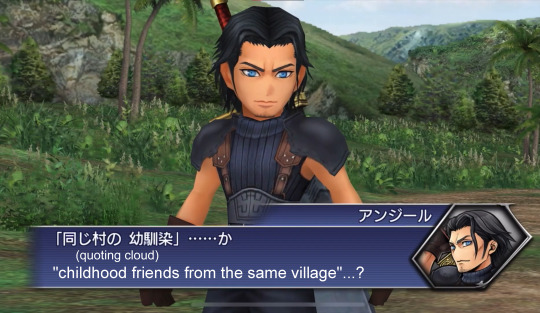
Both Cloud and Angeal feel responsible for protecting and looking after their loved ones, Angeal is seen as a caretaker type for this reason. Both Cloud and Angeal want to help fulfill the dream of their childhood friend, Tifa's was being saved by a hero and Genesis' being to share an apple with his hero Sephiroth. We see this when Cloud berates himself for not being the hero Tifa wanted and Genesis telling "Angeal" the dream has been fulfilled implying it has been something he knew about and wanted to help him achieve. Angeal's will in Lazard only fades away after Genesis said the dream came true, like there was a sense of fulfillment and that he could finally pass on after holding on for so long.
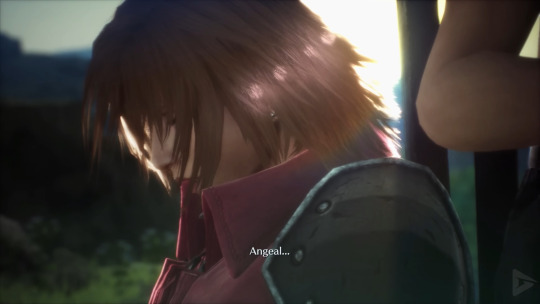
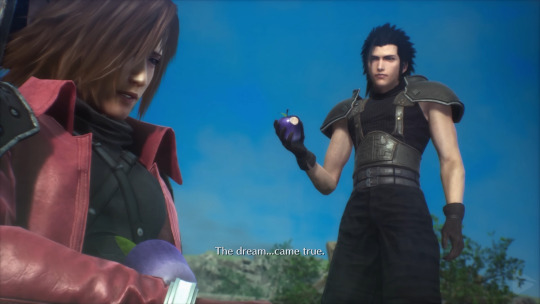
I find it interesting they intentionally draw parallels between Genesis & Angeal and Cloud & Tifa, people who have more explicit romantic feelings. I think Angeal and Genesis are supposed to represent a more “genuine” version of Cloud and Tifa’s relationship. Angeal represents the story cloud wanted to have throughout ffvii, having a childhood friend who never grew apart, who stayed together, and who followed a dream together. Angeal genuinely made soldier, and for a time he felt like he was in control of protecting others unlike Cloud. This contrast stays until the end, Cloud and Tifa learn to repair their relationship while Angeal and Genesis fall apart. Despite having everything Cloud wanted, it was not enough to sustain. This contrast is important in emphasizing that it is not about your background or your past, it is about what you do now and having people to fall back on. None of this is meant to be used as proof Genesis and Angeal are canon, but rather talk about Angeal's strong devotion and feelings for him since he was at least a teenager. They do not perfectly replicate the fall of mankind but it is interesting nonetheless. Here's to hoping we get to see more of how they interact in ever crisis.
#angeal hewley#genesis rhapsodos#final fantasy 7#final fantasy vii#crisis core#ffvii crisis core#ff7 crisis core#sorry this took so long executive dysfunction smile#removed link because I forgot tumblr hates that whatever
150 notes
·
View notes
Text
Yuya Florence Twst- The Shooting star over the Castle
Yuya doesn’t have a consistent personality throughout the main story as they are constantly going through changes. This is how they protected themselves through their life doing it subconsciously despite not having their memories.Some might say they’re a bit of an actress.
Yuya’s true personality does shine through at times mainly when they actually get to relax. They can be childish, petty and pretty chaotic sometimes letting the intrusive thoughts win but still an overall friendly person. Even then Yuya isn’t one to tell others how they’re truly feeling especially if they’re hurting. Even with all those things Yuya does know how to take charge and deal with serious situations. They’re definitely not the goody two shoes some perceive them as more of a trouble maker everyone will later learn.

💫Basic info💫
Age: 18
Pronouns: Doesn’t really care but others mainly refer to them as She/They
Height: 172cm
Birthday: August 8
Voice claim: JP - Ibuki Mioda(Danganronpa) ENG- Veronica (Heathers the musical OG)
Hometown: Earth, USA
Family: Lilian (mother-Deceased), Yolonda and Desmond (cousins) Yuya doesn’t concern them Family: Aunt and Uncle, Damien (cousin) , has a pretty big family in general
Class: 1-A
Dominant hand: Left
Nickname: Henchmen- Grim | Shrimpy/ Starfish- Floyd, Trickster-Rook | Herbivore/Omnivore- Leona | Child of Man - Malleus | Yu-Yu - Kalim, Cater, Lilia | Yu- First Years + Jamil | Troublemaker/Star - Idia | Star - Family | The Perfect- NRC
Favorite food: Chili oil Noodles, candied lemons , Strawberry lemonade
Like/hobbies: Cooking,Rhythm games, Horror movie/ Games, collecting bags , Photography, Crocheting and Knitting
Dislike: Forgetting things , Bland food , Green tea, overly strong smells, feeling sweaty, smell of alcohol, fuzzy socks , ants
Best subject: Alchemy
Talent: lock picking, cooking,Just having things , playing the Wind Instruments mainly the Flute
Club: Hops between clubs but mainly at the Board game or Basketball club

💫Extra Info💫
Yuya has thoughts of what were they like before Twst, this effects their relationships by them wondering if the way they are now is truly the real them. Would everyone still like me if I get my memories back and become myself again? Even with these thoughts Yuya still wants their memories back good or bad.
Yuya uses how others perceive them as to their advantage using this to navigate how to deal with situations.
Yuya doesn’t get their cardigan until Book 2 while everyone was visiting Trey.
The have a fight response most notable when they fought Riddle during orientation. Others thought it was some kind of adrenaline but Yuya does know how to fight and fight dirty.
Yuya was honestly in deep denial about being in Twst. Really much thought that they were in a dream up until the end of Book 2 from getting a scar from Leona’s overblot. This really woke them up to their new reality as before they thought “since I don’t belong here sure I’ll wake up to the place I truly belong.” [Also adding Yuya’s eyes technically wouldn’t be shown until this moment to show them waking up to reality]
Yuya develops a bit of an obsession for photography as the photos represents their memories. They hold these photos dearly scarred to forget again. Some say that Yuya’s photography can be scary being it can be used as blackmail
Yuya did have a hobby of journaling/ scrapbooking given the journal that they had in their bag when arriving to Twst but that was taken over by photography
The mirror called Yuya a shattered soul which not even Crowley understands why. This is due to their soul being shattered when being transported to Twst. Their soul will forever remain shattered
After every Overblot Yuya’s eyes will get darker they don’t really notice until after book 2. They will also get the full movie context. With movies not involved with the Overblots Yuya will get dreams in similar fashion and get the full movie after 3 dreams
Some of Yuya’s more noticeable habits has to be their strange ability to have everything in their pockets. No one knows where or how they even got it from. Another has to be staring only a few close to them can tell if Yuya likes or dislikes something by the way they stare.
Yuya is able to form bonds with many different beasts, creatures etc especially ghosts. Ghost often mistake Yuya as one of their own. Yuya thought being called a “beast tamer” was far fetched but can’t deny that they have a particular liking to them
Yuya grows insecure about the scar they gain after overblots even has troubles looking in the mirror.
It did take them awhile to warm up to others also given that in the beginning they were pretty quite. Grim, Ace and Deuce were the ones Yuya warmed up to the quickest.
Yuya does have conflicting feeling about being the Perfect but is scared of how others would treat them if they stopped.
Gave up on the thought of ever getting to go home during book 4 and focusing on how to get their memories.
Yuya does overblot which is triggered by them getting their memories back from fully dying in their original world.
Yuya never really asks for help for their self specifically but in a way that would help someone else. For example Grim asking them to call Crowley + text Ace and Deuce in book 4.
Yuya doesn’t really like the memory of orientation so doesn’t really attend things like assembly unless it something important like getting an Award. In the beginning they would get scolded but dropped it later on.
Yuya does sleep walk it’s a combination of stress/ Trauma and their shattered soul. When they sleep walk others will say they look like a wandering spirit.
Book 3 is when Yuya’s most noticeable changes happen waking up to their reality and changing the way they behave also every happening with Azul. After 3 Overblots they believe that this will be a reoccurring thing (they were right not to their shock)
Yuya is actually good at driving even when they have to be a bit reckless

💫Backstory💫
[ implied abuse]
Yuya lived with her mom Lilian pretty happily. One day Lilian had to go on a work trip promising to take them to the aquarium when she gets back but that day never came.
At the age of 5 Yuya lost their mother and was sent to live with their Aunt and her family. At first everyone was pretty sympathetic to Yuya but the true colors showed after so time. The Adults in their life valued appearances over everything. A stubborn child didn’t fit into their picture perfect ideal. So Yuya had to learn how to fit themself into the role their Aunt wanted them to. Sometimes using their mom against them other times different punishment.
This made Yuya close off their emotions and change their personality to whatever is deems fit. Throughout the following years Yuya would see themselves as “A shiny trophy for them to show off”.Put others before yourself, Help others with whatever they need. Earning them being seen as the “Star” of the community. But the one thing Yuya remember the most is Don’t expect anything in return that’s selfish.
“And selfishness gets you punished”
Enduring for years Yuya at 13 started to grow resentful. It started with small things misplacing items mainly targeted at Aunt, Uncle and Damien. This gradually grew into destroying things causing fights in the house. Things came to a head during a family reunion Yuya now 15 had a fight with Damien which lead to them falling down the stairs.
This event turned the family upside down reveling things happening behind closed doors. The main factors were Desmond waiting to expose the family and doctors seeing other injuries on Yuya. This lead to Community shunning most of the family. Other members would claim to not have known anything trying to get in Yuya’s good graces.
Yuya and Yolonda were sent to live with their grandparents who had no involvement distancing themselves from the family long ago. They have this belief that leaving that house would solve the situation and make them happy but nothing. Given everything that happened Yuya was honestly just tired and didn’t really trust their grandparents. They ultimately chose just to go on with life and leave things behind once they go to college.
💫Entering TWST/ NRC💫
The day before Yuya was supposed to be heading off to culinary school they wanted to visit their mom’s grave one last time. Unfortunately after saying their goodbyes they ran into Damien.
Trying to ignore the nonsense he was spewing they walked away. This was supposedly the wrong move as he grabbed Yuya still yelling. How Yuya ruined the family, how selfish they were and so on.
Scared and annoyed , Yuya started to fight their cousin off. Their emotions finally boiling over sick of everything Yuya punched Damien to the ground screaming about why can’t anyone just leave them be, “l wish I could just disappear from this place away from you , away from everything”. Within only a few seconds of that wish Yuya heard the sound of horses running looking up to see the black carriage coming up behind her cousin then everything went black.
The thing is only half of Yuya’s soul got transported to Twst that day. The other half survived currently in critical condition at the hospital but doctors are unsure if they’ll recover.

💫Gallery 💫
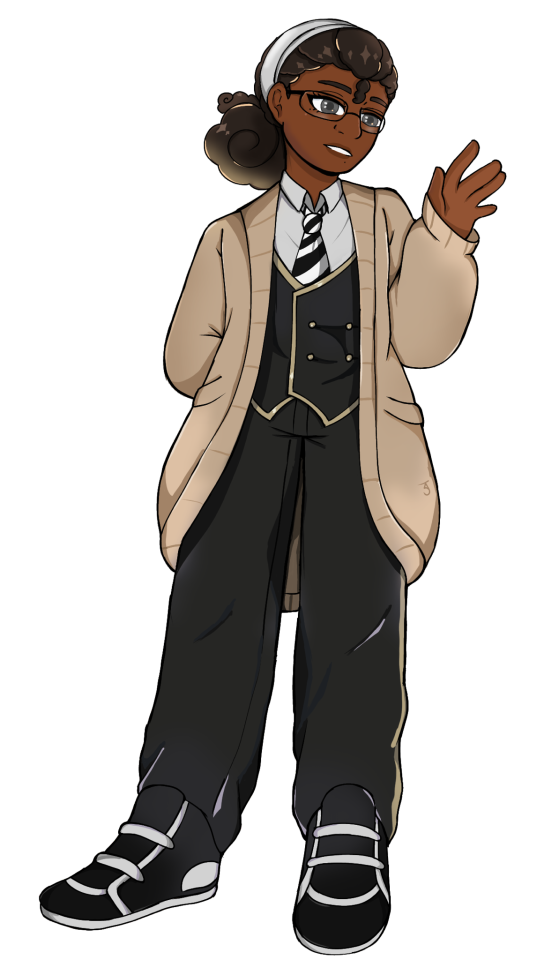
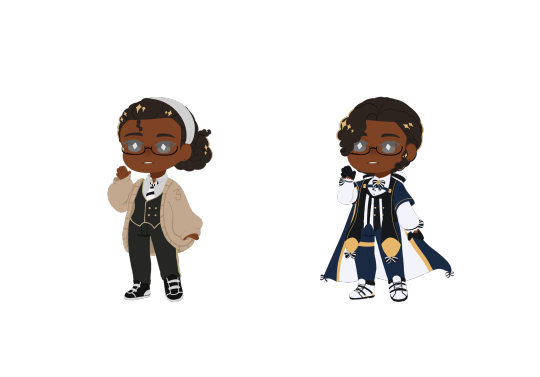
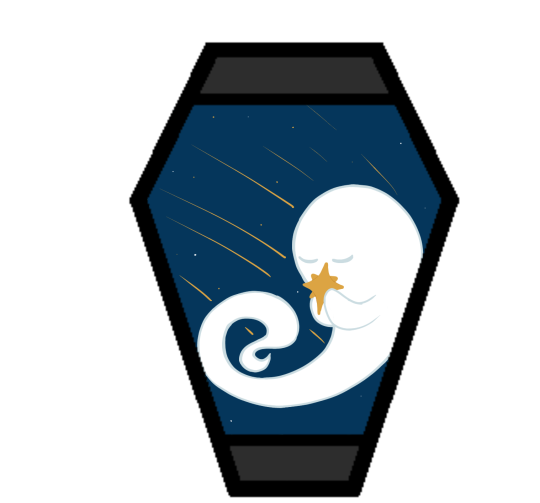

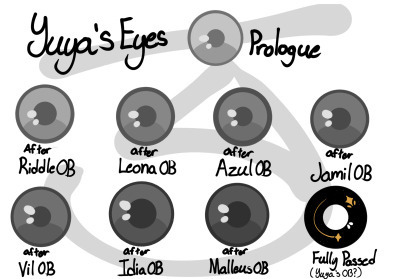

Divider
61 notes
·
View notes
Text

Tree of Void Emanation
The void of non-being emanates existence through a generative process and pattern which produces systems of increasing complexity and representative power. At the twelfth emanation we reach what is likely a limit of usefulness in balance with complexity.
Each emanation builds contains and is connected to the previous emanations. The term “sphere” is used as is common in platonic and qabalistic systems as an to reference the formative principles of each emanation. The term “path” describes the connections between the spheres.
Each sphere is counted in two ways, once by sequence starting from zero and again by prime number starting from one. Zero and one represent the identity functions of addition and multiplication. Each subsequent is then given its own sigil which is produced from merging the numeric sigils of its sequence and prime. The pronunciations of the spheres are similarly generated by combining the pronunciations of these numbers.
From this numeric skeleton the story of manifestation is developed upon it both as structured metaphor and ontological framework. Exploration of this framework reveals formulas and techniques for relating to and manipulating reality through the arts of magick.
Chaos 0⋮1 - nĕsh-hĭn - /nɛʃ.hɪn/
Existence emerges spontaneously and without reason from Void. Existence requires no reason. As the Void has no quality whatsoever it is in no way restricted making it the root generative force. This is the fundamental nature of existence. It is spontaneous and without purpose or design. All possibilities assert themselves into being at once, each becoming a “one”, a unity of existence unto itself while retaining nothing in itself.
Process 1⋮2 - hĕzh-ēsh - /hɛʒ.iʃ/
That which asserts itself into being does not exhaust possibility. Every aspect of being is incomplete, retaining its relation to void while constraining and permitting that which may follow. Each emmanation leaves space for the next emmanation so that the process may continue. All connection is made possible by what is left undetermined and reality is never fully manifest.
Pattern 2⋮3 - ēs-ŭzh - /is.ʌʒ/
As the process of manifestation proceeds the shape of the unmanifest spaces influences that which may follow. This causes patterns to arise that unify the discrete units of being. Though each is completely free and separate, they are also manifest as a unified pattern. It is precisely because of incompleteness that these units are able to also become a new unity.
Form 3⋮5 - ŭm-o͞os - /ʌm.us/
Within pattern there emerge forms defined by the pattern and yet independent within it. For example, 5 & 7 are a twin prime pair as they are both prime with a difference of 2. Other twin primes pairs include 11 & 13, 17 & 19, 29 & 31. All prime pairs greater than 3 & 5 have the property of having their sum being evenly divisible by 12. This form of a “prime pair” is well known in mathematics but primeness, divisibility, and addition were not in any way defined in order to produce this form. Number emanates the form of the prime pair. Likewise we may take nearly any game and learn its rules rather quickly, but to learn a strategy is an entirely different matter. Games like Chess or Go give rise to whole vocabularies for naming forms within them. Though the rules teach us how to play, one must become familiar with these forms to play well.
Change 4⋮7 - ăou-chăz - /aʊ̯.t͡ʃæz/
Manifestation may stop at Form to make a complete but static world. The universe of number is a perfect example of static manifestation. Alternately manifestation may remain forever in flux, manifesting and collapsing back into the unmanifest. This gives rise to time and change. Further manifestation takes on a destructive aspect as forms that were can now also cease to be. We move up a level in our analysis to describe types of change and change itself becomes a new type of form. The mathematically inclined may find it useful to meditate on the relationship of a mathematical function and its derivative.
Self 5⋮11 - o͞or-fĕm - /uɹ.fɛm/
In the flow of change through time forms emerge which influence change in order to sustain themselves. These forms are agents of change. Like the first cellular organisms self-organizing around volcanic vents on the ocean floor in the chemical soup of the earth’s ancient oceans. The basic aspect of these agents is homeostasis. These agents direct change to create a dynamic constant. As these agents guide change we may now call this activity Will. In the fullness of emanation we come to identify one of these agents with the self.
Sense 6⋮13 - jŏth-tŏi - /d͡ʒɑθ.tɔɪ/
Agents may be blind actors, no more than a self-catalyzing reaction, or the agent may develop the capability of sensing and reacting to its environment. Sense is the essential element of the encounter of that which is beyond the self. It is the beginning of external self-organization that leads to external manifestation. It is an echo of Process yielded through the incompleteness of the agent.
Thought 7⋮17 - chō-kou - /t͡ʃoʊ.kaʊ̯/
If what is sensed leaves its mark upon the agent then we find the seed for the emergence of representational systems. The agent can now experience itself in time, forming memories, and gains the ability to not just change behavior based on current circumstance but also based on past learning. These internal marks can then be sensed and manipulated and so give rise to symbol, language, and communication.
Desire 8⋮19 - ät-thĕl - /ɑt.θɛl/
Having formed memory the agent now is able to experience the external as something to be sought after or avoided. Want and fear and all the aspects of emotional attachment emerge. Desire attaches the agent to the external and so opens a channel for the external to truly manifest. It is attachment to the world that makes the world. We regard this as a positive development, an overcoming of the limited solipsistic self through desire.
Object 9⋮23 - ĕ-pĕp - /ɛ.pɛp/
Through desire the agent manifests the objectively real. The external is truly manifest beyond whatever sense, thoughts, or desires the agent may hold regarding it, so completing the self-overcoming of the agent. The objective binds the agent while also making possible the emergence of the next level of agency within objective reality. The agent has surrendered its naive omnipotence in its embrace of a new greater level of being in which it only has marginal and indirect power in exchange for a greater state of being.
Subject 10⋮29 - vŭ-sōb - /vʌ.soʊb/
The manifestation of objective reality allows the agent to itself become a manifest object. By surrendering itself into objectivity and becoming limited the agent is able to enter into a space where it can come into authentic contact with other agents manifest as other subjects. Each aspect of the agent obtains and is constrained by a physical correlation. For us humans, this is our brains. Every thought, sense element, and desire is within our brains and is lost to us with disruption of this fragile tissue.
Kia 11⋮31 - fĕ-shĕr - /fɛ.ʃɛɹ/
Kia is the void which remains within manifestation. In the twelfth tree all has manifested and yet Nothing remains. This Nothing is experienced as consciousness, free will, and ecstasy. More than that, Kia is the basis of having any experience whatsoever. All of the aspects of manifestation through the agent can carry on quite well without any conscious experience or free choice within it. In dreamless sleep and in normal waking when on auto-pilot Kia retreats. Kia manifests as the absurd, wonder, the presence of the undefined and unknown. Kia can arise in quiet contemplation, ecstatic overload, and in many ways that open the fundamental questions of being.
127 notes
·
View notes
Text
Game Pile: Kentucky Route 0, One of Three Games About America
youtube
Script and Thumbnail below the fold!

Kentucky Route Zero is a magical realist point and click game of what I’d normally call Narrative Adventure, which came to kickstarter in 2011, then came out in 2013, 2014, 2016, and 2020, because you can’t have nothing for free, even things you pay for. The game is a text-driven game without any of the trappings of your typical point-and-clicker where you jam a ladder in your pants and try to work out why you want to put green dye in the water fountain. Instead it follows the haunted mind of Conway, a trucky driver and his interactions with small handful of people on a part of the Kentucky Interstate, while he to find the place he needs to do his delivery, despite being utterly lost.
I enjoyed what of Kentucky Route Zero I played, but the thing that stands out to me in hindsight is its sound design. It’s a beautifully defined game, audio-wise, with all sorts of thoughtful foley for its environments, and the way that even the pieces of the interface that Conway interacts with have their own sort of specific authentic sounds, chonks and thunks and ch-zzzzses.
It’s also visually splendid, beautiful in what it tries to represent in the heightened reality of its setting but also the format of a videogame. These places look good from the angle that’s chosen, creating lines of artwork and bars of cages, depending on what you’re focusing on, and by being a fixed-camera story of its type, Kentucky Route Zero takes on traits of theatre, with blocking and careful positioning and timing all making up part of how the story unfolds.
A story I haven’t finished.
See, I don’t feel like playing Kentucky Route Zero Act V.
Sit down, traveller. Let me tell you a story.
There’s a chance you’ve heard this story before. I’ve anonymised it here, not because I think you shouldn’t be able to work out who it is, but because the idea of focusing on the who runs the risk of ignoring the what. Plus, I don’t want to direct anyone to a person who said something stupid and encourage fights. That’s not the important issue.
This is the story of when someone perfectly represented something, and probably never realised it.
You will sometimes hear me talk about the take that ‘there are three games about America,’ with a tone of utter revulsion and derision. This is from an incident back in 2020, when a game developer and advocate for inclusive games, had an opinion, on the internet. This advocate is well-established and has a big audience, but also, he’s crucially, not a white guy, not a Christian guy, and not an American guy. These are factors that play into what he said, which was, in summary, that while Kentucky Route 0 was no doubt phenomenal, he wasn’t interested in playing it right now.
To this, an actual adult responded with:
This is legitimately the worst take you’ve ever had. There are only about three games that are actually American, and this is one of them. Everything else is designed for export. Kr0 is a precious and valuable thing. It is of immense and intense personal importance.
Now, resisting the urge to argue with a tweet, which is just generally a bad practice that leads to doing things like wanting to be on twitter, and setting aside this tweet conflating ‘this is of personal importance to me’ and ‘this should be of importance to you,’ this position describes the idea that there are only three games that are ���actually American.’
What does it mean to be ‘actually American?’
America is a pretty pervasive presence, if you’re not aware of it. Most people in the world have to know about what’s going on in America. We know about your Presidents and your Senators and your Constitution, to the point where people can be more aware of how your country’s laws work than their own country’s laws. I’ve often seen it held up as an example of how poorly educated people in say, Canada and Australia are that we believe we have, say, a ‘first amendment right,’ but the thing is you have to ask why there is that.
We watch so much American TV.
We listen to American music.
We try to make our news broadcasts look like yours, because that’s what real and legitimate news looks like. We try to retell your stories in our local languages because that’s what real media looks like. Our children sing songs in your accents because that’s the culture that a multi-trillion dollar economy has pumped into the whole world.
America demands we attend their wars and surrender our living to become their dead and when we are done America sells the survivors a cheeseburger.
This is not a remarkable or controversial statement. You must know, this is not even vaguely challenging to know about. Everywhere in the world is replicating parts of the American empire, because America exports and enforces the vision of the American empire. McDonalds may sell curry in India, but it’s very important that the curry being sold is McDonalds curry because that is how you know it’s an American style curry.
What this means is when someone tries to assert there are only really three games about America, that’s a kind of specialised brain rot that requires you to consider games that are very much about America as not being really about America. And thus we see the other thing about America, which is it’s not enough for America to be the most important place in the world that everyone else in the world needs to recognise, but also, most of America is inadequately America for this vision of America. You saw this in the wake of 9/11, and the election of Barack Obama: huge amounts of American media resurged in extolling the values of ‘real’ America, as opposed to the parts of America where the vast majority of Americans lived, which just so happened to paint a lot of marginalised people living in the cities as ‘fake Americans.’
I am not bringing you unique information. This is just obviously true things if you don’t live within the boundaries of an environment that flatters you as the most normal thing in the world. The vast majority of the world is not America. There are eight billion people in the world, more or less, meaning that America is about 4% of the world, and yet, it is catastrophically, overwhelmingly, deleritously the common touchstone for how things are ‘supposed’ to work. This is through media imperialism, which is mostly supported by American companies exporting all their media to foreign markets extremely cheaply.
‘about three games that are actually American.’
This fascinating piece of doofusry still, even now leaves me agog. ‘Actually American.’ Kentucky Route 0 is actually American, you see, as opposed to… what? Is America’s Army one of them? You know, the game financed by the American Army? What about Call of Duty, a franchise that is in part subsidised by American military complex manufacturers? What about Grand Theft Auto, a videogame that tells the rags-to-riches story of American excess in criminality, setting aside the way it’s made by a Scottish company. Actually American, because American doesn’t mean America, it means one tiny little pool of ‘America’ where the speaker can imagine there’s a realness and an authenticity to the America-ness that doesn’t involve all the messy realities of what it is to be America. It’s the towns of hard-working people, that suffer under your particular description of oppression, whether that’s cities full of nonwhite people or corporations bleeding the country dry, always eliding the social cruelties and terribleness of these places, as if giving people money stops them from being bigoted (for example).
This is then used to recruit these poor, superior Americans, the you know, America Americans, whose sufferings are noble and whose authenticity cannot be impeached and they are then used as a defense against criticism of, you know, America. It’s the same speech Charlie Daniels gave about how foreigners may think they could push around Barack Obama (a dude who bombed a lot of shepherds with the most elaborate and brutal military ordinance in the world) but they were going to have a harder time taking on Americans who wrestled alligators, who at this point have exactly zero recorded drone strike kills.
This is because America America isn’t real.
‘Real’ America is a nebulous nothing that you can project whatever you want onto, and which is also not responsible for anything terrible that America does. It’s not the American Empire, it’s not the exporter of culture, it’s somehow purer, better, a sort of individualised folk who are to be protected and extolled, shriven of all the things about America that make it anything but its perfect idealised form of America.
I could go on.
I really could.
This is something that defines the world I have to live in. I speak English. I’m white. I’m from a coloniser state. I should be able to integrate easily and smoothly into the white supremacist capitalist hierarchy of American culture, but we are told, that no, we are not acceptable. We are only valid as long as our differences are invisible. We, a real people, do not get to have opinions on America, because we do not know True America. When you spell colour wrong in a chat message, when your accent isn’t quite right, when you don’t know the difference between junior and sophomore year of high school, then you are shown, you are evinced, and you are made very aware that you are other, you are outside, you are wrong.
And really, there’s no good reason for it. We send our soldiers to America’s wars, we buy America’s submarines, and we sing your songs. Our currency mimics America’s, our culture permeats with America’s, we even have such a crushing inferiority complex about the empire that there’s an academic term for what we feel about our own media compared to the media of the truer, proper empire to which we are vassal.
The term is ‘cultural cringe,’ and it was coined by Henry Lawson, who you, odds on, have never heard of. In 1894, he wrote:
The Australian writer, until he gets a “London hearing,” is only accepted as an imitator of some recognized English or American author; and, as soon as he shows signs of coming to the front, he is labelled “The Australian Southey,” “The Australian Burns,” or “The Australian Bret Harte,” and lately, “The Australian Kipling.” Thus no matter how original he may be, he is branded, at the very start, as a plagiarist, and by his own country, which thinks, no doubt, that it is paying him a compliment and encouraging him, while it is really doing him a cruel and an almost irreparable injury. But mark! As soon as the Southern writer goes “home” and gets some recognition in England, he is “So-and-So, the well-known Australian author whose work has attracted so much attention in London lately”; and we first hear of him by cable, even though he might have been writing at his best for ten years in Australia.
This is imperialism. This is a way in which we have been induced and brought by the empires around us to accept their ways as correct, as the normal, as default. And that is the mindset you must have if you want to look at the breadth of videogames, with their American ideas like health insurance, readily available guns, the importance of freedom, the ubiquity of air travel, the branding and iconography of types of food and the sports metaphors and then say ‘yeah, this doesn’t have anything to do with America, not really.’
Anyway, this thread, this incident, was a big deal at the time, in that there were a lot of people from within the community of game developers and journalists who seemed very happy to line up and get mad at a brown foreigner for being inadequately enthusiastic about the possibility of playing a videogame. But don’t worry, after a day or two, an apology was forthcoming for all of this fracas, by which I mean, the original developer apologised for being so thoughtless as to, again, express honest lack of enthusiasm in a videogame.
For me, this was a kind of break point, where I started just blocking indie devs on sight. I don’t want to know what they’re involved in, I don’t want to promote their work, and I will hold tiny grudges against them that I do not seek to transfer or encourage in others. This was one silly incident in which a lot of people said something silly because they don’t know better, or they’re arseholes.
None of this is fair to Kentucky Route 0. It’s a game with its own intentions and its own perspective. It’s not trying to make this conversation happen. Kentucky Route 0 has been choked and gripped by this position around it, where to talk about an American game, someone put a cross on it that made it the avatar for All Things America. The wild thing to me is that I had, prior to this point, played two episodes of Kentucky Route 0. I thought it was pretty good, and I liked what it did with the negative space of dialogue options – when a character you’re controlling makes excuses, the excuses you choose show you other things you could be making excuses about that you, the player, didn’t know beforehand. That’s some good Narrative Storytelling Design, I like that a lot. But now I can’t really engage with Kentucky Route Zero because the main thing it makes me think about is how this final chapter, meant to round out the game’s story and present a conclusion and a point, became this flashpoint for a lot of people to be very casually racist.
Which kinda poisons the whole thing for me. It’s an authentic thing, I’m sure, it’s a thoughtful thing, too, but the people stepping up to say I should care about it did so in a way that made me hate them.
Any time you see me say ‘three games about America’ I’m talking about this, and the attitude of a particular kind of American that America is, as always, exceptional. It’s real easy to not realise when you’re just voicing your self-centeredness and how easy that is to ignore the opinions of people around you and what they’re saying. This is what I’m talking about when I mention ‘the three games about America.’
[fade for credit text]
By the way, the three games about America are Crash Bandicoot, Sam & Max Hit The Road, and Bust A Move.
68 notes
·
View notes
Note
what are your opinions on hades (the game)?
I played the first game and it was fun to play with nice mechanics and some difficult boss fights to beat. The background design was also very beautiful
That said my issues again are to the character designs as well as how the story was. The developers to make Zagreus and Melinoe would have to research and in their research there's no way they didn't know that Zagreus IS Dionysus. You can't separate their shared story. Now it would be more fun to actually include these two as protagonists learning about their story.After all Zagreus was supposed to be heir to Zeus and Hera made the titans tear up a baby. That's why he's mentioned as thrice born because he born first by Persephone, later by Semele then finally from Zeus. If the story genuinely cared they would try to include Orphism.
Also the gods designs. Last year, I made a post highlighting how many recent depictions of the Olympians follow a Hollywood-style approach to diversity one that caters mostly to an American audience. I got a lot of hate for simply pointing out historical facts about my own culture and its mythology.
Let me clarify: I'm not against diversity in media. But when we're talking about ancient Greek gods, who were created by a specific people in a specific region, there's historical context that matters. These gods were imagined to look like the people of ancient Greece not like a modern, globalized society. Greeks at the time were part of the broader Mediterranean world, and while there was variety in features (olive skin tones, curly or straight hair, dark or light eyes), they were still ethnically and culturally Greek. There were no Black or East Asian gods in the pantheon this isn't exclusion, it's just historical reality.
What I find frustrating is that when I or other Greeks express concern about how our cultural heritage is being reinterpreted through an American lens, especially in character designs, we’re often met with hostility. There’s this idea that unless the gods visually represent American-style diversity, they’re somehow "wrong" or outdated. But it’s equally wrong to erase or ignore the identity of the people who created them.
Greek gods were meant to reflect Greek ideals and aesthetics. Representing them with appearances totally detached from Greek features erases a part of that identity. Yes, we Greeks are white by general classification, but that doesn't mean we all look the same there's a wide range of Mediterranean and European features that are authentic to our people. Skin color is only one small part of a larger cultural and visual heritage.
This isn’t about gatekeeping, but about cultural respect. Just as we wouldn’t redesign Norse gods as looking nothing like Chinese or Egyptian gods without their cultural elements, the same respect should apply to Greek mythology. It's not bad to ask for historical and cultural accuracy ,about representing cultures as they actually were, not as others imagine them to be today.
17 notes
·
View notes
Text
"A god of tengu-warding": uncovering the connection between Okina and tengu

There’s something uniquely magical and captivating about Okina’s dialogue in HSiFS that neither subsequent final bosses nor even her own subsequent appearances manage to capture. Probably no other character managed to directly reference quite as many myths and religious concepts in her debut game appearance. And yet, without context many of these probably seem borderline nonsensical. Interviews and supplementary material sometimes help, but even that isn’t guaranteed. This article will focus on only one such instance, the notoriously mystifying exchange between her and Aya which simultaneously casts her as a “god of tengu-warding” and implies a degree of kinship between them. What does this mean? Why does Okina have something to do with tengu in the first place? Where do tengu come from, anyway? Why crow tengu aren’t necessarily crows? Why is it possible to make a case for Byakuren being a tengu? This - and more - will be explored under the cut.
Matarajin and tengu, from tengu odoshi to Hidden Star in Four Seasons
In Aya’s route in Hidden Star in Four Seasons, Okina calls herself “a god of tengu-warding”. This is actually not something ZUN invented. Matarajin was the focus of a medieval Tendai Buddhist ritual known as tengu odoshi (天狗怖し) - “placating the tengu”. He was most likely himself understood as a tengu in this context. As such, he had to be placated by the monks performing the ritual, whose chaotic actions - chiefly noisy recitation of random sutras coupled - were meant to imitate his own behavior.
This approach is somewhat unusual: in many other similar ceremonies an appropriate deity or deities would simply be invoked to get rid of demonic interlopers. Here the risk of obstruction is so great that only by pretending to play along with it victory can be attained. Or, alternatively, perhaps to get rid of Matarajin and other tengu, the monks had to beat them at their own game by creating an even more disorderly display. Yet another option is that Matarajin had to be attracted with the ritual in order to ward off other, lesser tengu. No matter which interpretation is correct, it is evident there was a direct connection between them.
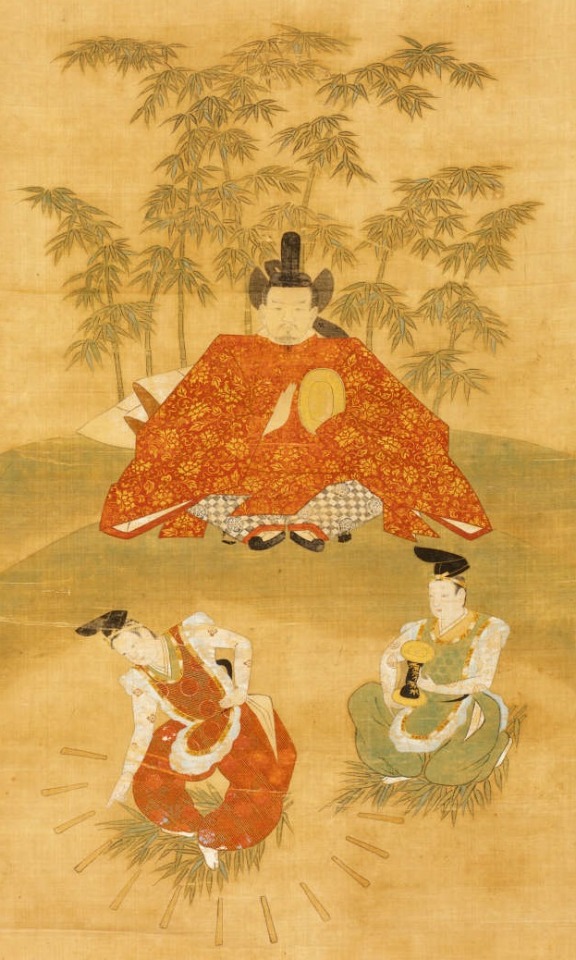
Matarajin and his attendants (Rhode Island School of Design Museum; reproduced here for educational purposes only) As a curiosity it’s worth pointing out that it has been suggested that tengu odoshi and other similar rituals and festivals might have resulted in the development of Matarajin’s well known role as a deity of the performing arts, especially noh, exemplified by his equation with a stock character from sarugaku, Okina, an auspicious old man represented by a characteristic bearded mask. Comparisons have also been made between the tengu odoshi and rituals involving Matarajin’s attendants Chōreita Dōji (丁令多童子) and Nishita Dōji (爾子多童子). Fittingly, one of the spell cards of their Touhou counterparts Mai and Satono is named Mad Dance "Tengu-Odoshi".
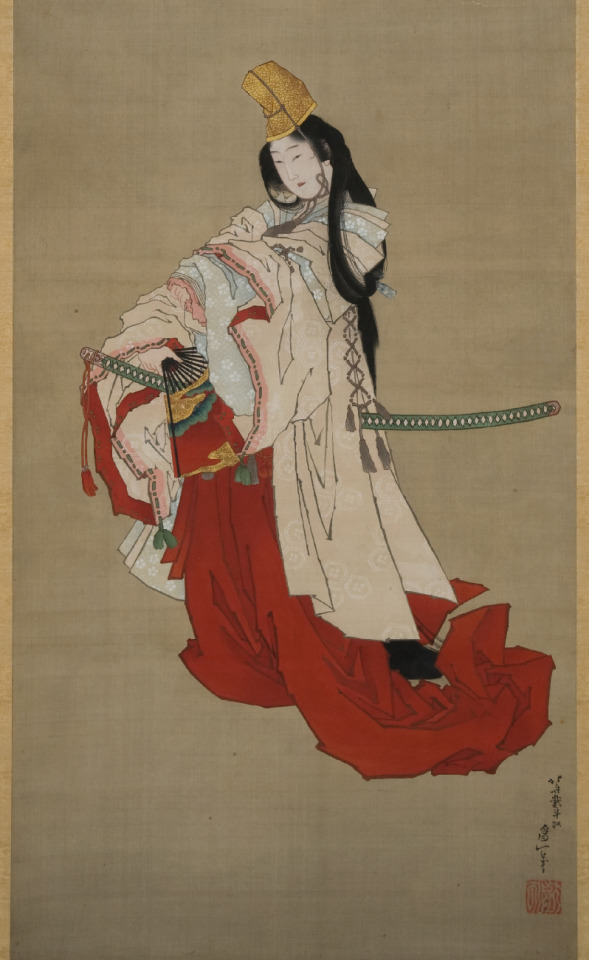
Shizuka Gozen performing in typical shirabyōshi attire, as depicted by Hokusai (wikimedia commons)
While this is only tangentially related to Matarajin, it’s worth pointing out that according to Yasurō Abe, it was also believed that tengu were enthusiasts of the performing arts in general. However, while Matarajin was associated with noh, tengu favored an earlier form of entertainment, shirabyōshi (白拍子). This term refers to a type of female dancer who performed in male formal wear. The reference to tengu enjoying their dances and songs might be an allusion to emperor Go-Shirakawa, who was known for similar artistic tastes and was commonly represented as a tengu in legends.
The association between Matarajin and tengu was also present in shugendō. In Kumano, local shugenja apparently perceived him as a tengu-like deity comparable to Iizuna Gongen (飯縄権現). It’s worth noting this is in theory who Megumu is based on, but tragically ZUN didn’t want to do much with the irl background in her case, so I doubt we'll ever see a reference to this in canon media.

An Edo period depiction of the ox festival of Matarajin (wikimedia commons)
It seems the only other possible reference to Matarajin as a tengu is a depiction of the famous (relatively speaking) Kōryū-ji ox festival from the Edo period Miyako Meisho Zue (都名所圖會) in which the person playing his role wears a tengu-like mask.
Considering ZUN has to be aware of at least some of the scholarship pertaining to Matarajin and tengu - tengu odoshi is not exactly a famous ritual, and most of the search results today are just Touhou - it seems safe to say that he had this very connection in mind. Aya mentions a category of beings she refers to as “people of impairments”, which according to her encompasses both the tengu and their metaphorical relatives who “hid behind Buddhas”, like Okina. This neatly corresponds to their shared role of their counterparts in medieval and early modern Buddhism.
In addition to the connections between Matarajin and tengu discussed above, there are multiple other instances of identifying him as a member of a category of beings usually perceived ambivalently, if not outright negatively, specifically because of their ability to impair the pursuit of enlightenment. If you read my previous post focused on Okina-adjacent topics, you already know that Matarajin was closely associated with dakinis, for instance. It’s worth noting that as an extension of this connection, he could also be associated with foxes. The Edo period treatise Inari Jinja Kō (稲荷神社考, “Reflections on Inari Shrine”) outright says that matarajin, treated as a generic term, not a given name, is one of the the terms which can be used to refer to supernatural foxes.
The oldest presently known reference to Matarajin describes him as a “yasha deity” (夜叉神, yashajin). This term is a loan from Sanskrit yakṣa, and refers to a class of nature spirits or low-ranking deities incorporated into Buddhism from preexisting tradition of India. They are portrayed as generally benevolent and protective. To be a yaksha in origin is no shame for a deity, despite their low status and occasional ambivalence. Bishamonten, who needs no introduction, as well as Konpira, the foremost of the Twelve Heavenly Generals, are both portrayed as yakshas who embraced Buddhism. Even the bodhisattva Kannon seemingly was portrayed as a reincarnation of a female yaksha named Cundī early on. In both China and Japan, the most widespread image of a yaksha is ultimately that of an armed, protective figure.
However, sometimes negative traits can be ascribed to yakshas too. For instance, the Tang period Buddhist scholar Guifeng Zongmi maintained that yakshas are child-eating demons - though he also recorded a custom of dedicating children to them in order to prevent them from harm. The tenth century Tendai monk Genshin stated they were among demonic beings who could potentially obstruct rebirth in a pure land. However, it was possible to solve this problem with the right rites. The examples listed above are just a few glimpses of one of the most recurring topics in historical Japanese Buddhist literature: there were demons, and even deities (障礙神, shōgejin) keen on impairing the pursuit of enlightenment unless properly placated. This would either ward them off, or even turn them into fierce protectors of Buddhism instead (what ZUN presumably meant by Aya’s comment about “hiding behind Buddhas”). However, most of such beings originated in India and spread alongside new religious movements. How did tengu join their ranks? To answer this question, I will need to go beyond Matarajin and further back in time, to the Heian and Kamakura periods.
Makai, the realm of tengu
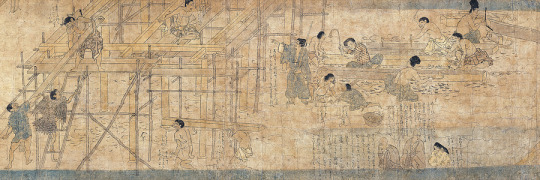
A group of Tengu constructing a temple in the tengu realm (wikimedia commons)
The emergence of tengu as a well defined class of beings is fundamentally tied to portraying them as a source of hindrances for practitioners of Buddhism. In the twelfth century, they came to be identified with the concept of ma (魔), a loanword from Sanskrit māra. In this context, it is to be understood as obstruction of enlightenment, or opposition to the Buddha, his teachings and the Buddhist law. There are both internal sources of ma, like doubt and worldly attachment, and external ones. Tengu, generally speaking, fall into the second category.
Tengu were believed to be reincarnations of those who lack bodhicitta (菩提心, bodaishin), the mindset necessary to pursue enlightenment. Those who become tengu at least nominally follow Buddhist teachings, but fail because of arrogance, greed and other earthly attachments. Those who mislead others by promoting incorrect practices also turned into tengu after death.
Many tengu narratives from the Heian period and the middle ages portray them as possessing extraordinary powers, which they use to trick and mislead monks and laypeople alike. They could be referred to as gejutsu (外術), literally “outside techniques”. A related term is gedō (外道), “outside way”. These labels are not necessarily pejorative, and can refer to any practices which are not strictly Buddhist, for example to Confucian or Daoist ones, and in fact some were integrated with Buddhist practices. However, depending on context other options might be preferable. For example, Haruko Wakabayashi went with “wicked sorcery” in her translation of a Konjaku Monogatari tale in which a tengu poses as a buddha in order to mislead laypeople. However, even if tengu could imitate miracles Buddhas and bodhisattvas were believed to perform, their results were only temporary because they lacked true power. In many tales the effects of tengu tricks only last seven days.
According to the Kamakura period anthology Shasekishū (沙石集), not all tengu are malicious, despite their origin. Those who are close to being redeemed, while held back by “superficial wisdom”, curtail the influence of their more malevolent peers and thus act as protectors of Buddhism. They eventually leave the realm of tengu. Other sources indicate that the malign tengu are destined to eventually be reborn as animals.
As already pointed out above, the notion of tengu being opponents of Buddhism already appears in Konjaku Monogatari, composed between 1120 and 1140. The tales involving them appear in the final chapter of the section focused on Buddhism in Japan, which sets them apart from most other supernatural beings. They are instead grouped with accounts of visits in hells and other realms of rebirth, and with narratives explaining the consequences of accumulation of bad karma.
In the Kamakura period, tengu received their own place in the Buddhist cosmos: an entire realm of rebirth. It didn’t replace any of the three other realms where one reincarnates as punishment due to accumulating bad karma - these of hungry ghosts, animals, and hell. It could be sometimes described as a specific hell (one of many) or as a part of the animal realm, but generally it was held to be something distinct. While still perceived negatively, it can effectively be considered a preferable alternative to rebirth as an animal or in hell, since to be reborn as a tengu does not necessarily prevent one from seeking enlightenment.
The realm of tengu was variously referred to as tengudō (天狗道; “realm of tengu”), madō (魔道; “realm of ma”) or makai (魔界; “world of ma”). The last of these terms has been present in Touhou for a while, though never in association with tengu, at least for now. I am aware many people are attached to the PC-98 portrayal of Makai and to Shinki, but I would argue there are endless possibilities in trying to make the medieval understanding of this term work in this context as well. Most notably, the notion of monks who failed in their pursuit of enlightenment would have interesting implications for Byakuren. Following medieval Buddhist logic, one could argue she is essentially already a tengu, even though ZUN refers to “sealing” in Makai, as opposed to being reborn there. She may deny it herself in Symposium of Post-Mysticism, but it's hard to argue with the evidence.
The oldest work establishing the existence of tengudō as a distinct realm of rebirth is Hirasan Kojin Reitaku (比良山古人霊託; “The Spiritual Oracle of the Old Man of Mount Hira”), in which the Tendai monk Keisei (1189–1268) learns about it from a tengu residing on Mount Hira. While left anonymous, the being states that he was alive in the times of Shōtoku and before the rise of Fujiwara no Kamatari to prominence, and explains that due to worldly attachments he was reborn in the realm of tengudō. He then provides information about many of Keisei’s family members and contemporaries, as well as assorted historical figures. Some of them have shared a similar fate, including emperors Sutoku and Goshirakawa and prominent members of Buddhist clergy like Ryōgen, Jien, and many others. Keisei and the anonymous tengu then engage in what I can only describe as a vintage example of power scaling, and start to compare the strength of the individual tengu (as we learn, Go-Shirakawa is more powerful than Sutoku).
Curiously, the anonymous tengu is entirely self-aware, and explains that his mind is filled with illusory thoughts, but proper Buddhist observance can nonetheless save him and other tengu from their current state. He notes that Ryōgen was able to leave the realm of tengu already, for instance. Another peculiar aspect of this account is the explicit reference to female tengu. The protagonist explains to Keisei that his wife is a fellow tengu, though she is only 400 years old. He also specifies many other tengu have families and even children.

A debate in the tengu realm (wikimedia commons)
The Buddhist views on tengu became firmly cemented thanks to the Tengu Zōshi (天狗草紙), a set of seven illustrated scrolls. This work most likely originally arose in the thirteenth century, in an era of conflicts between the well established esoteric schools of Buddhism, Tendai and Shingon, and the newcomers to the scene, like Zen and Pure Land. All parties involved accused each other of spreading false teachings and embracing ma. The new schools did not form a unified front, for clarity: for instance, Nichiren denounced the Shingon establishment about equally enthusiastically as Zen or Pure Land. There were also voices presenting the very act of criticism of other schools as worthy of critique in itself. The goal of Tengu Zōshi was to criticize and satirize the various vices of contemporary Buddhist monks by presenting them as tengu. It states that there are seven kinds of tengu, corresponding to seven different sorts of pride (citing Haruko Wakabayashi: “feeling slightly inferior to those who are greatly superior, feeling superior to those who are inferior and equal to those who are equal, feeling superior to those who are equal and equal to those who are superior, feeling superior to those who are superior, being attached to oneself, committing evil and thinking one is virtuous, and feeling enlightened when one is not).
Five of the tengu types are supposed to represent monks of major temples of this era (Kōfuku-ji, Tōdai-ji, Enryakuji, Onjō-ji, and Tō-ji), the remaining two are yamabushi (mountain ascetics) and “recluses” (tonse). However, the scrolls culminate with a reveal that all of the depicted tengu attained salvation and eventually became Buddhas (save for Ippen, who was instead destined to be reborn in the animal realm). This once again puts an emphasis on tengudō not being quite as bad as the other paths of rebirth which should generally be avoided: one has to actually practice Buddhism in some form to get there in the first place, and it is possible to attain enlightenment as a tengu.
The notion of tengudō and tengu being fallen monks did not vanish after the middle ages, and appears for example in some tales about Yoshitsune’s youth and his training with these beings, for instance in the Miraiki (未来記; literally “chronicle of the future”). Therefore, it is safe to say that this is the closest thing to a universal explanation where do tengu come from. However, their history actually goes even further back.
Cats, comets, dogs and kites: the origin of tengu
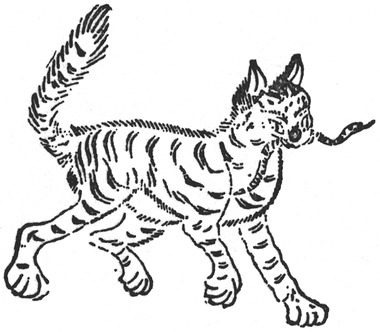
A tiangou from the Classic of Mountains and Seas (wikimedia commons)
The history of tengu starts in China. At least the history of the name, that is. The word 天狗, which in Chinese is read as tiangou, already occurs in the Classic of Mountains and Seas, probably composed at some point in the second half of the first millennium BCE, either near end of the Warring States Period or in the beginning of the reign of the Han dynasty. While tiangou can be literally translated “celestial dog”, the creature is actually compared to a wildcat with a white head, and makes catlike sounds on top of that. It is also said to repel evil forces. This quality is also reaffirmed by the poet Guo Pu, who additionally states the tiangou is so small that a ruler could either eat it or wear it as a belt ornament to make use of its protection.
Next to this whimsical image of a benevolent supernatural creature, the term tiangou was also used to refer to comets and similar celestial phenomena. This meaning of the term entered Buddhist texts, for example in the Sutra on the Bases of Mindfulness of the True Dharma (正法念處經, Chinese Zhengfa Nianchu Jing, Japanese Shōbō Nenshokyō), tiangou serves as a translation of the Sanskrit term ulka, which refers to meteors. The astral tiangou eventually developed its own supernatural associations in China, becoming a sort of dog-shaped astral demon. I cannot cover this topic extensively here, but you will find plenty of information, including a first hand account of a modern celebration tied to these traditions, in Xiaosu Sun’s article in the bibliography.
The earliest Japanese reference to 天狗 occurs in the Nihon Shoki (completed in 720), specifically in the section recording the events from the reign of emperor Jomei (593-641). The reason why I’m using the kanji here is that the reading is not necessarily intended to be tengu in this case; the gloss indicates it is actually to be read as amatsukitsune, “heavenly fox” (I’ll go back to this term later). However, Haruko Wakabayashi states it’s safe to assume that it was used here in the astronomical Chinese meaning. The passage refers to observation of a comet, which reportedly made the sound of thunder as it passed from east to west.
Some other early references to tengu occur in literature of the Heian period (794-1185). In this context, this term seems to refer to nondescript mountain spirits. They were believed to possess people to make them fall ill or to cause disorder. All around it seems they weren’t really meaningfully distinct from any other beings or phenomena which could be subsumed under the label of mononoke (物の怪), and it's not clear how their name came to be applied to them. In the early twentieth century, the folklorist Kunio Yanagita tried to prove these early tengu might have represented people pushed into the mountains by the spread of a centralized Japanese state. However, this theory never took off. Even some of Yanagita’s contemporaries, especially Kumagusu Minakata, were critical of it, and it’s just a weird curiosity today. Similar assumptions were proven correct in the case of tsuchigumo, and might be correct in the case of some oni tales, but these are matters for another time.
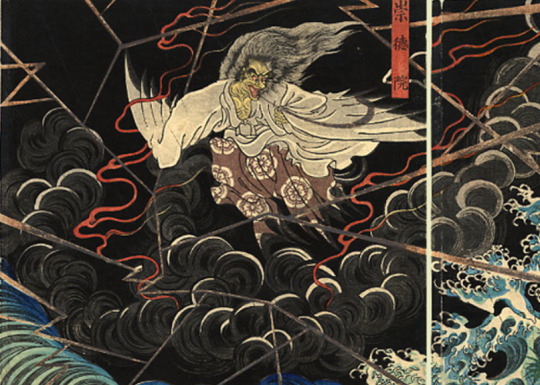
The supernatural form of Sutoku, as depicted by Yoshitsuya Utagawa (wikimedia commons)
Notably, in the Heian period it was already believed that one can reincarnate as a tengu, though this belief didn’t become quite as well defined as it was in later sources. Probably the oldest story like that states that the monk Shinzei (真済; 800-860) a disciple of Kūkai (774-835), became a tengu and subsequently tormented empress Somedono (染殿后; Fujiwara no Akirakeiko), the wife of emperor Seiwa. In later tradition, emperor Sutoku came to be viewed as the archetypal example of a human who reincarnated as a tengu; it should be noted he was simultaneously viewed as a vengeful spirit (怨霊, onryō), though.

A kite-like tengu, as depicted by Sekien Toriyama (wikimedia commons)
The well known association between tengu and birds is already present in Heian sources too. Today, the bird-like depictions of tengu are known as “karasu tengu”, literally “crow tengu”, and in many modern works, including Touhou, this moniker is taken literally. However, through history the birdlike elements of the tengu were typically those of a bird of prey, not a corvid. As I mentioned, kites were the most common, but for example some depictions of Iizuna Gongen are eagle-like. This convention might have been influenced by garudas, a class of bird-like Buddhist protective figures.
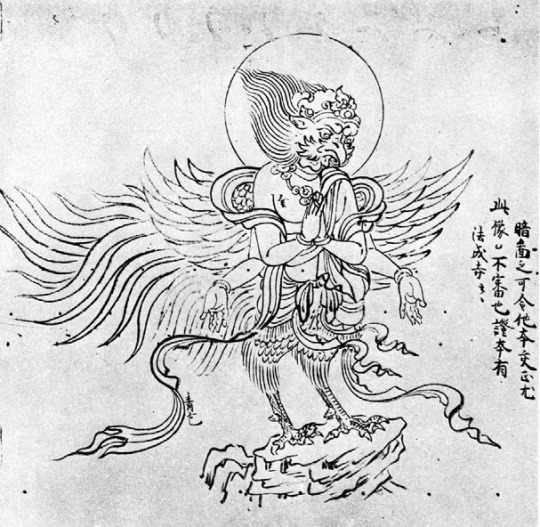
A depiction of a garuda from Besson Zakki (別尊雑記), a Heian period Buddhist iconographic compendium (via Bernard Faure’s Rage and Ravage; reproduced here for educational purposes only)
Descriptions of tengu explicitly mentioning their resemblance to kites are quite common. In Zoku Honchō Ōjōden (続本朝往生伝; “Continuation of the Biographies of Japanese Reborn in a Pure Land Continued”) Ōe no Masafusa (who you might remember from my Ten Desires article) mentions a tengu turning into a kite to spy on a virtuous monk. In the historical epic Taiheiki Sutoku, presented as the ruler of all tengu, is said to have the form of a golden kite. However, in at least some cases tengu are not necessarily birds themselves, but merely use them as mounts. Granted, both traditions could coexist: Hirasan Kojin Reitaku explains that tengu ride kites, but it also describes them as possessing the legs, tail and wings of a bird themselves.
The oldest source to feature a large number of images of bird-like tengu is the already discussed Tengu Zōshi. These include high-ranking monks with beaks, yamabushi or monks with wings and beaks, slightly more bird-like figures portrayed largely without clothing, and finally non-anthropomorphic kites. There are also illustrations of seemingly regular humans labeled as tengu. Haruko Wakabayashi concludes that the use of multiple distinct iconographic types in the same scrolls might reflect belief in a hierarchy of tengu, with the beaked monks representing the upper echelons of the tengu society and the other varieties their servants. The regular kites presumably hold the lowest position. The tengu world thus seems to reflect a contemporary idealized image of Buddhist hierarchy, with lower ranking practitioners, wandering ascetics and laypeople guided by senior monks.
ZUN kept the notion of tengu hierarchy, though the classes listed in the relevant entry in Perfect Memento in Strict Sense are largely his invention, or at least represent pretty extensive reinterpretation (for instance, tengu dressed up as yamabushi aren’t associated with printing in any particular way). While many of these changes work very well with his idea to adapt the traditional role of tengu as peddlers of dubious interpretations of Buddhist doctrine and false miracles with a fresh twist by making them purveyors of misinformation, I will admit I’m not sure where did the idea of wolf tengu come from, as it fits neither this theme nor any genuine tengu background. The wiki insists that’s a reference to the Chinese tiangou, but I’m not buying this.
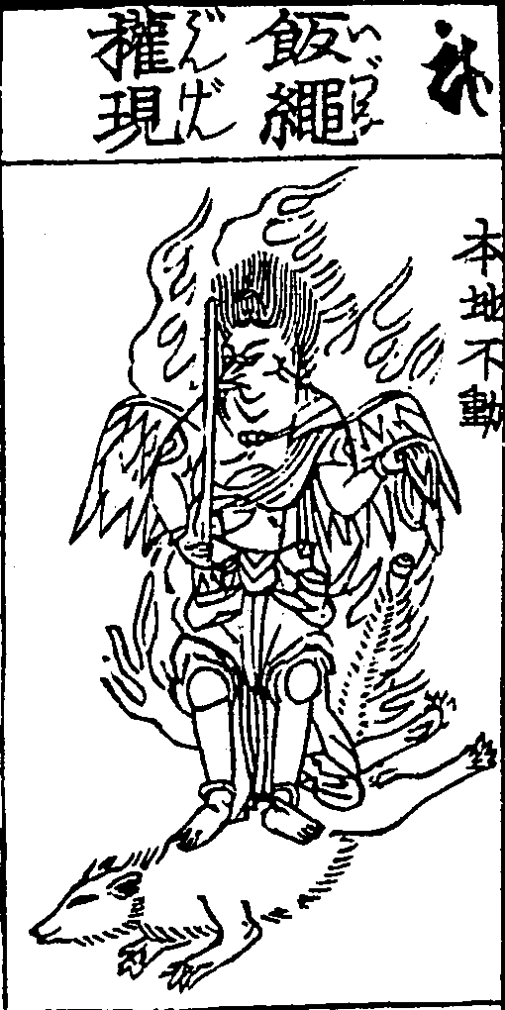
Iizuna Gongen riding on the back of a celestial fox (wikimedia commons)
I would argue foxes would probably work better than wolves. In some cases due to phonetic similarity a degree of conflation, or at least confusion, could occur between tengu and tenko (天狐), “heavenly foxes”. The fourteenth century treatise Byakuhō Kushō (白寶口抄) states the tenko has the form of a kite, for instance. It’s also why Iizuna Gongen was sometimes referred to as Chira Tenko (智羅天狐). The link with foxes was hardly universal, though. For example, it is absent from the tradition centered on Mount Atago, in which in addition to birds, tengu are associated with wild boars. Note that a myth dealing with Iizuna Gongen’s arrival in Japan does indirectly link this location with foxes, but this is basically extending his own connections to other tengu.
While the discussed animal connections are quite important for tengu iconography, I was unable to find any evidence that there was ever a particularly strong belief in mundane animals turning into tengu, as Aya’s bio from Phantasmagoria of Flower View would imply. The only source I am aware of which would state that directly is Atsutane Hirata, one of the most fanatical kokugaku authors, and even he still states that at least some tengu were reincarnated Buddhists. Note that his works are generally not a record of genuine mythology or folklore, but part of an effort to “purify” Japanese culture which directly led to the birth of the “contemporary” form of expansive nationalism. In any case, Hidden Star in Four Seasons and the historical context of information it provides opens the possibilities for much more interesting and unique tengu backstories than just stage 2-worthy beast youkai fare.
To sum up, while individual stories might portray tengu as arriving in Japan from Korea (Tarōbō), China (Zegaibō and his prototype Chira Yōju) or even India (an anonymous tengu in Konjaku Monogatari), these reflect the routes across which Buddhism was transmitted to Japan. The tengu as a distinct supernatural creature had elements which originated abroad, obviously, but ultimately represented a strictly Japanese contribution to Buddhist demonology. At least some Japanese authors were already aware of this in the middle ages, as evidenced by the Shasekishū.
The three meanings of 天狗 - the tiangou, the astral object and the tengu - are explicitly described as distinct from each other in the encyclopedia Jakushōdō Kokkyōshū (寂照堂谷響集) compiled by the monk Unshō (運敞; 1614–1693). The original tiangou is described here as a type of tanuki which eats snakes, but this doesn’t exactly contradict the Chinese description I’ve mentioned before, as 狸, the character referring to wildcat in Chinese, was adopted to represent the name of tanuki in Japanese. The astral tiangou is described as a “tengu star” (天狗星, tengu-sei) which has the form comparable to a dog. Unshō stresses that both of these are distinct from the Japanese tengu, despite their names being written identically. He places the tengu in the entourage of Mara, alongside dakinis and vinayakas (in this context demons representing something like an evil counterpart of Ganesha as a remover of obstacles).
Beyond animals: the long nose tengu and Sarutahiko
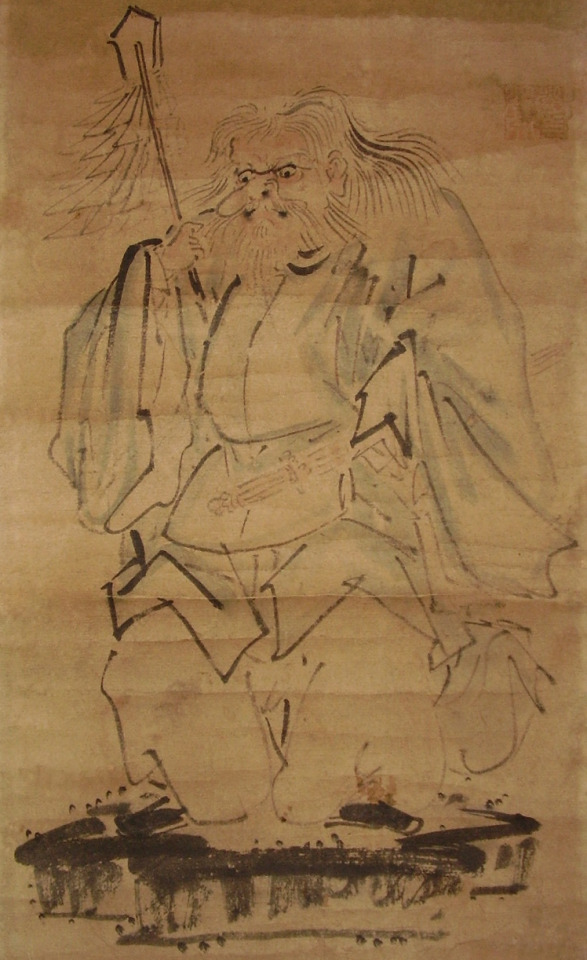
A Meiji period depiction of Sarutahiko (wikimedia commons)
A final matter which needs to be addressed here is a theory that tengu imagery is derived from Sarutahiko, which for some reason has been placed in the lead of the tengu article on wikipedia despite being hardly relevant academically. This proposed connection relies on the fact that from the very beginning Sarutahiko was described as long-nosed. In the section of the Nihon Shoki dealing with the “age of the gods”, the oldest text he appears in, it is said that “his nose is 7 feet long”. His other physical characteristics are also exaggerated, to be fair - he is said to be unusually tall, and his eyes are enormous too. All around, this description is presumably meant to make him seem intimidating. Still, the nose is what visual arts tend to highlight, sometimes for comedic purposes.

A long-nosed tengu, as depicted by Hokusai (wikimedia commons)
This characteristic also led to a development of a folkloric connection between Sarutahiko and the one type of tengu depictions I haven’t discussed yet - the long-nosed tengu, commonly called daitengu or “great tengu”. The origin of this iconographic variant remains poorly understood. While by far the most recognizable today, they are a relatively recent artistic convention - the oldest examples only date to the late fifteenth or early sixteenth century, and they only became widespread in the Edo period. By then, tengu were present in Japan for some 700 years, and Sarutahiko doesn’t come up in sources describing them (and vice versa).
It also needs to be stressed that while the daitengu still have some birdlike traits, Sarutahiko lacks a connection to birds altogether. Instead, he is associated with monkeys (tengu never are, contrary to an unsourced claim on wikipedia). Historically he could even be identified with Daigyōji (大行事), a deity from Mount Hiei depicted with the head of a macaque.
It’s not impossible that the specific long-nosed type of tengu depictions was based on depictions of Sarutahiko, but it’s equally likely the influence actually went into the opposite direction (most depictions of Sarutahiko are from the Edo period or later, and most shrines dedicated to him are fairly recently established too, even though he was worshiped in one form or another through earlier periods already).
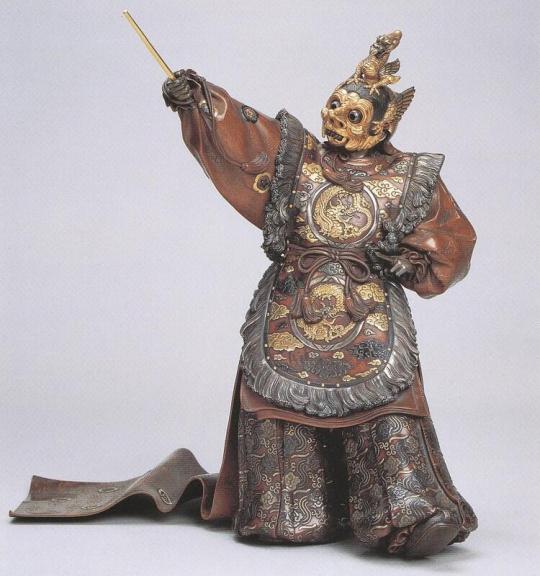
A statuette of a dancer wearing a Raryō-ō costume by Shōmin Unno (Imperial Household Agency; reproduced here for educational purposes only)
Bernard Faure notes it’s also not impossible that both Sarutahiko’s iconography and the long-nosed tengu are simply both reflections of something else altogether, and suggests the long-nosed Raryō-ō (羅陵王; sometimes shortened to Ryō-ō, 陵王) masks used in bugaku performances as one possible candidate. Ultimately none of these possibilities can be proven conclusively, though, and it’s best to maintain caution.
ZUN seems to believe there is some truth to the proposal that tengu were derived from Sarutahiko, judging from the fact he referenced this connection multiple times in various ways. The oldest example are Aya’s spell cards in Mountain of Faith. It also comes up in Symposium of Post-Mysticism, where Miko and Byakuren seem to basically treat it as a fact. Aya in one of the short articles from the same book declares that “when it comes to white beard in Gensokyo, we tend to picture Sarutahiko. (...) he is also the god of us tengu”. Putting aside the latter claim, which is bit of a reach when it comes to real beliefs, it’s worth noting that the mention of the white beard is a pretty deep cut. It was actually not a part of Sarutahiko’s original iconography, but rather an addition which developed at the Shirahige Shrine on the shores of Lake Biwa. Originally the local deity, Shirahige Myōjin (白鬚明神), was considered a distinct figure. However, at some point he came to be identified with Sarutahiko, and the names seem to be used interchangeably in medieval and later sources. As a result, the latter received the former’s signature white hair and beard.
While despite the existence of a genuine connection it is a stretch to call Sarutahiko a “god of tengu”, let alone their leader, this does not mean that figures which can be described this way are absent from tradition. In fact, I mentioned a number of them in passing in the previous sections. However, describing them in more detail a topic for another article. Look forward to "Tenma, boss of the tengu". Exploring the "heavenly demon(s)", coming next year!
Bibliography
Yasurō Abe, The Book of “Tengu”: Goblins, Devils and Buddhas in Medieval Japan
Bernard Faure, Protectors and Predators (Gods of Medieval Japan vol. 2)
Idem, Rage and Ravage (Gods of Medieval Japan vol. 3)
Michael Daniel Foster, The Book of Yokai. Mysterious Creatures of Japanese Folklore
Sarah Fremerman Aptilon, Goddess Genealogy: Nyoirin Kannon In The Ono Shingon Tradition in: Charles Orzech, Richard Payne & Henrik Sørensen (eds.), Esoteric Buddhism and the Tantras in East Asia
Wilburn N. Hansen, When Tengu Talk. Hirata Atsutane's Ethnography of the Other World
Richard E. Strassberg, A Chinese Bestiary: Strange Creatures from the Guideways Through Mountains and Seas
Xiaosu Sun, Liu Qingti's Canine Rebirth and Her Ritual Career as the Heavenly Dog: Recasting Mulian's Mother in Baojuan (Precious Scrolls) Recitation
Haruko Wakayabashi, The Seven Tengu Scrolls. Evil and the Rhetoric of Legitimacy in Medieval Japanese Buddhism
Idem, Monks, Sovereigns, and Malign Spirits: Profiles of Tengu in Medieval Japan
Duncan Ryūken Williams, The Other Side of Zen: A Social History of Sōtō Zen Buddhism in Tokugawa Japan
175 notes
·
View notes
Text
Learning How to Play Protect the Child: Part 6: Trust.
If you have never played a Forged in the Dark game before, picking up one can be intimidating, and that includes Protect the Child.
In Part 1, I introduced the Action Roll, as well as Position & Effect. In Part 2, I talk about Assembling your dice. In Part 3, I talked about Resistance. In Part 4, I brought up Stress and how it works uniquely in Protect the Child. In Part 5, I talked about Rest Stops.
I’ve finally arrived at a place where I can talk more about some of the mechanics of this game! So welcome to another How-To.
This week I’m going to talk about Trust!
Over the course of play, your character will need to work to make the Child comfortable in order to help them grow as a person, as well as encourage the Child to listen to the crew. This is represented through two, connected elements. One is your personal Trust Box, while the other is the Child’s Trust Clock.
Your Trust Box
Your Trust Box is a resource that you either have or you don’t. If you have it, the Child trusts you, and gaining further trust is easier. If you don’t have it, the Child doesn’t trust you. This means that getting them to listen to you might be more difficult, and continually letting them down will also make them trust the entire crew less.

At the same time, Trust is also a resource. You can choose to spend your Trust to get the Child to follow one of your orders without question, if you need to get them out of danger, or do something without causing any complications.
The Trust Clock
The Child has their own Trust Clock, which represents their relationship to the crew, rather than the individual characters. This clock fills whenever you…
take a moment to acknowledge the Child’s wants or needs
protect the Child from physical danger
show investment in the Child’s thoughts and feelings
take steps to bring the Child closer to their goal.
There’s also actions you can take during your Rest Stop to build up that Trust!
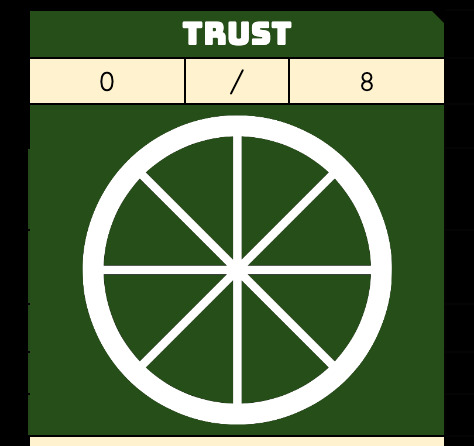
If you have your personal Trust Box filled, it becomes much easier to fill the Trust Clock. If you don’t have your Trust box filled, that Trust Clock also empties a lot faster, especially when you take actions that put the Child in danger or make them upset.
When the Trust Clock drops below 2 marks of Trust, the Child marks an Emotion, representing how losing their sense of security causes them turmoil. When the Trust Clock fills at 6, the Child becomes comfortable enough to let you learn something about them: a Thing That Is True. As your relationship develops, the Child becomes a more fully realized human being, and they also mark a point of experience.
If you want to start learning how to play Protect the Child, I recommend taking a look at the Learner's Guide, which you can download at the store page! I also have a number of Quickstarts that come with pre-generated characters, which cuts down learning how to create a character.
I also believe that playing is one of the easiest ways to learn, so if you want some hands on experience, hop into the playtest discord! There is at least one game happening every week designed to be easy for first-timers to hop into and give it a whirl.
32 notes
·
View notes
Text
---WRITTEN A WHILE AGO AND KEPT IN DRAFTS FOR WEEKS UNTIL I THOUGHT ABOUT IT AGAIN---
i hate how comfortable most of the mouthwashing fandom is with calling a disabled burn victim "a baby", or making fanart of him BASICALLY representing him like some kind of pet. his wide eyes are not for your cutesy purposes. he does not look like "the autism creature" because of his limbs. you guys are infantilizing and absolutely dehumanizing this character, and through him, in a sense, showing a few of your unfiltered thoughts about the disabled community! he is not the silly mascot of the group!!! HE IS A FLESHED OUT DEEP CHARACTER WITH HIS OWN MORALS AND HIS OWN MISTAKES!!!! AND HIS STATE DOES NOT MEAN HE BECAME A THOUGHTLESS BLAMELESS BABY!!!!!!!!!!!! HE IS NOT A PET NOR A MASCOT!!!!! JUST DRAW POLLE THE PONY (THE ACTUAL MASCOT) AS THE MASCOT!!!!!!!!!!!!!! what in the actual hell is wrong with you people.
to be CLEAR this isn't only about the fandom on tiktok : i've seen countless fanarts on here being like "he looks so cute here", or drawing the other characters "holding him" like a plushie or a pet (if you can visualize what i mean) and damn, unfortunately tumblr is just as bad as tiktok sometimes
ALSO this isn't either about being able to find humor in media that aren't comedies, because yes the babygirl/blorbo/pathetic meow meow thing is prevalent in every fandom imaginable and especially for older, "masculine/tough" male characters. Which I understand even if I don't partake in it, since it's all just one big joke. Hannibal Lecter or Gus Fring covered in blood is babygirl, let's put a bow png on him. hahaha. how novel. But this is not what's happening here. you guys are not calling him baby or babygirl because he's hot or the comedic effect of calling an edgy tough guy a baby. the joke is supposed to be about the absurdity/contrast of calling those kinds of characters (murderers, criminals, old mean guys, buff masculine superheroes, or in general "stereotypical" masculine guys) "babygirl". But here it seems overwhelmingly sincere. and that's extremely concerning!!!!!!!!!!!!!!!!!!!!!!!!
and if you want to look at it from a different/narrative perspective :
obviously there was thought put into why this happened to curly, why he looks like this, why jimmy's the one who put him through this, why it's jimmy that gives him the painkillers and why the painkillers are pills in the first place. there is thought behind his state and how it mirrors anya and what jimmy put her through. and not only is curly a metaphor for society IN OUR CURRENT MODERN WORLD in his reaction and INACTION towards what happened, the FANDOM/PUBLIC's reaction to curly and the overall plot is also a great mirror to hold up to ourselves. I won't go into detail about my full analysis of this BUT AlleyDreamer's "You Are Missing The Point of Mouthwashing" youtube video, and @/luckylefty's tiktoks about the games are both eloquent and clear and i highly recommend watching them.
SO....if you view curly's impotence, suffering, dehumanization. and overall physical state as something that can be meme'd or funny, you probably have not considered that part of the narrative that the game developers explored. and if you have and think that somehow it's still all good jokes to make EVEN when considering that joking about his state is also making a joke out of anya, out of women, out of disabled people, DAMN do you absolutely SUCK. is that really the best you can come up with?
SO. all in all. i understand lightening the mood of the fandom by ignoring the elephant in the room and choosing to just focus on jokes, but PLEASE stick to jokes about the group and their game nights and the shenanigans, daisuke and swansea's father-son relationship, or even the game's low-poly graphics and animation - hell, stick to replaying that swansea twerking clip again and again. BUT FOR THE LOVE OF EVERYTHING ON THIS EARTH KEEP YOUR ABLEISM, SEXISM/MISOGYNY AND TONE-DEAFNESS TO YOURSELF !
ok rant over cough cough
#mouthwashing#curly mouthwashing#mouthwashing game#captain curly#mouthwashing fanart#mouthwashing analysis#ableism mention#ableism in fandoms#just a long rant in general#if i get one “that one too woke friend” joke in my asks i'm gonna riot DO YOU HEAR ME.#GOOD NARRATIVE MEDIA WITH POLITICAL MESSAGING IS BOUND TO STRIKE UP POLITICAL CONVERSATIONS!!
38 notes
·
View notes
Note
I watched Castlevania: Nocturne the otger day and liked it a lot less than you seemed to, so I want to hear a more detailed opinion if you have one. Am I in the wrong to think it was more shounen and less "deep" in some way?
I'd say it's definitely more shounen. Introducing the "Richter can't do magic because unresolved trauma" thing right from the jump meant a Believing In Yourself powerup was pretty much inevitable, but I liked the execution of that scene enough that I didn't mind much.
It doesn't quite have the backbone of the original Castlevania, which was grounded so strongly in Dracula's apocalyptic grief - a motivation the audience is directed to find deeply understandable from minute one - that it gave the characters a solid thematic core to play off of. This let the writing stay pretty tight by letting Trevor serve as a foiling mirror for Dracula in their mutual disgust with the failures of human kindness, Sypha for Lisa in their altruistic use of their knowledge and their vilification for "witchcraft", and Alucard in the middle torn between worlds.
Nocturne is more loose and character-driven, but it still has a core theme - the argument over "the natural order" and how that plays into a fear of change from those currently on top. However, Richter doesn't really have a horse in that race, since his motivation starts and ends at Kill Vampires while everyone around him is more complex, trying to overthrow the aristocracy and free the enslaved and such. I think this makes Richter feel a little less important than Trevor was, narratively, because he sort of stands apart from the core philosophical debate at play. It took me a few episodes to get what his deal was and start caring about his self-actualization, and I think he's definitely got further to go. Possibly Alucard's presence in season 2 will give him more to play off of.
I think Nocturne has several independently interesting villains instead of one really good villain, which is a complaint I also saw about Castlevania season 4 - I liked Death just fine, but he really didn't work for everyone, and the secondary villains like Saint Germaine were much more interesting and complex. Nocturne does, however, pull off something Castlevania didn't as much, which is most of the characters acting on their own internal consistent motivation without cleanly falling into the "good guy" or "bad guy" box, causing them to slide into and out of conflicts and alliances depending on the circumstances.
I feel like Bathory is kind of a weak core villain with almost no human-level motivations or ideas beyond General Villainy, and the extent of her development being a darkest hour shonen villain powerup/frieza transformation doesn't help much, which is why I'm kind of holding out hope that they just bite the bullet and bring back Dracula. He's the nemesis from the Castlevania games, and while they gave him and Lisa a happy ending in Castlevania season 4, I don't think they need to keep him on the bench forever. It's been 300 years, Lisa is almost certainly long dead again and Dracula doesn't need to be full Mad With Vengeance Burn Down The World to still be a credible problem in need of a little Belmonting.
I had fun with season 1 of Nocturne with the understanding that the first four-episode "season" of Castlevania wasn't representative of the final shape of the story either. Sypha's character, for instance, was very flat before she and the gang went on their season 2 bonding adventure, not much more than some banter and infodumps. I think Nocturne did solid setup of the cast and the theme they'll be unpacking, and it has lots of room to explore these characters in interesting ways once they energy-ball-tennis Bathory out of the way first.
190 notes
·
View notes